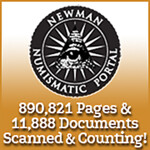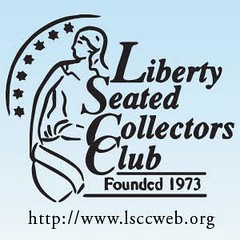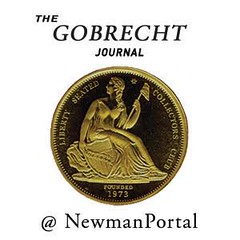
About UsThe Numismatic Bibliomania Society is a non-profit organization devoted to the study and enjoyment of numismatic literature. For more information please see our web site at coinbooks.org SubscriptionsThose wishing to become new E-Sylum subscribers (or wishing to Unsubscribe) can go to the following web page link MembershipThere is a membership application available on the web site Membership Application To join, print the application and return it with your check to the address printed on the application. Print/Digital membership is $40 to addresses in the U.S., and $60 elsewhere. A digital-only membership is available for $25. For those without web access, write to: Terry White, Treasurer AsylumFor Asylum mailing address changes and other membership questions, contact Terry at this email address: terrywhite5475@yahoo.com SubmissionsTo submit items for publication in The E-Sylum, just Reply to this message, or write to the Editor at this address: whomren@gmail.com
BUY THE BOOK BEFORE THE COINSale Calendar
|
- WAYNE'S WORDS: THE E-SYLUM FEBRUARY 26, 2017
- NEW BOOK: A GUIDE BOOK OF U.S. COINS, 71ST EDITION
- NEW BOOK: IMAGES OF VALUE
- MERCANTI TO RECIEVE DAVID RITTENHOUSE AWARD
- A MINT CHIP IN THE NEWMAN COLLECTION
- IMPERFECT COINS SOUGHT FOR WHITMAN PROJECT
- NOTES FROM E-SYLUM READERS: FEBRUARY 26, 2017
- PROFESSOR HELLMANN'S 1970S TEST NOTES
- WHAT THE NOBEL PEACE PRIZE MEDAL LOOKS LIKE
- COLONIAL ARCHAEOLOGIST NOëL HUME
- VOCABULARY TERM: OVAL MEDAL
- RALPH RANDOLPH BARKER (1856-1913)
- REDFIELD HOARD HOUSE FOR SALE
- WHEN TIFFANY REDESIGNED THE GREAT SEAL
- 1823 FIND OF OLD NEW JERSEY COPPER
- THE END OF CIRCULATING GOLD IN THE WEST
- ARTIST LAURIE MCGAW'S CANADA 150 COIN DESIGN
- ENGLISH BREAKFAST CONSIDERED FOR COIN DESIGN
- NUMISMATIC NUGGETS: FEBRUARY 26, 2017
- MORE ON NOODLE MONEY IN AMERICAN PRISONS
- NEW YORK TIMES REVIEWS IMAGES OF VALUE EXHIBIT
- NORTHWEST TERRITORIAL MINT OWNER LOSES $38M VERDICT
- WAYNE'S NUMISMATIC DIARY: FEBRUARY 26, 2017
- MEDALS OF WILLIAM SHAKESPEARE
- MEDALS OF BONNIE PRINCE CHARLES
- MEDAL MARKS 450 YEARS OF NETHERLANDS MINT HISTORY
- CANADA'S NEW ENDANGERED ANIMAL CUTOUT COINS
- PETITION SEEKS TRUMP U.S. GOLD COIN
- COUNTERFEITING CURRENCY FOR THE VIETNAM WAR
- BILL ENGRAVED WITH MICRO-PORTRAIT FOUND
- INDIA ATM DISPENSES PLAY MONEY
- CHINESE BANKNOTE BOUQUET
- FEATURED WEB SITE: THE GREAT SEAL
Click here to access the complete archive
To comment or submit articles, reply to whomren@gmail.com
Content presented in The E-Sylum is not necessarily researched or independently fact-checked, and views expressed do not necessarily represent those of the Numismatic Bibliomania Society.
WAYNE'S WORDS: THE E-SYLUM FEBRUARY 26, 2017
New subscribers this week include: A. Rahn, Rich Mahan. Welcome aboard! We now have 2,727 subscribers.
Thank you for reading The E-Sylum. If you enjoy it, please send me the email addresses of friends you think may enjoy it as well and I'll send them a subscription with your compliments. Contact me at whomren@gmail.com anytime regarding your subscription, or questions, comments or suggestions about our content.
This week we open with two new books, a Rittenhouse award, and a piece of the first United States Mint. Other topics this week include imperfect coins, the Nobel Peace Prize medal, the Redfield Hoard, the Great Seal of the United States, William Shakespeare, Bonnie Prince Charles, a Trump gold coin petition, and a banknote bouquet.
To learn more about collector Ralph Randolph Barker, Tiffany designer James Horton Whitehouse, painter Alonzo E. Foringer, the Puffin Coinage of Lundy, Professor Hellmann's test notes, and oodles of doodles and noodles, read on. Have a great week, everyone!
Wayne Homren
Editor, The E-Sylum

NEW BOOK: A GUIDE BOOK OF U.S. COINS, 71ST EDITION
 The 71st edition of the hobby’s Guide Book of United States Coins (popularly known as the “Red Book”) will launch at the Whitman Baltimore Coin and Collectibles Expo on March 30, 2017. It features new and extensively updated content reflecting the current market for collectible coins. To celebrate the 225th anniversary of coinage at the Philadelphia Mint (1792–2017), the hardcover version of the Red Book’s 71st edition includes a commemorative gold-foil portrait of David Rittenhouse, first director of the Mint, who was appointed by President George Washington. The Red Book can be pre-ordered online (including at Whitman.com) in several formats, and after the Expo will be available from booksellers and hobby shops nationwide.
The 71st edition of the hobby’s Guide Book of United States Coins (popularly known as the “Red Book”) will launch at the Whitman Baltimore Coin and Collectibles Expo on March 30, 2017. It features new and extensively updated content reflecting the current market for collectible coins. To celebrate the 225th anniversary of coinage at the Philadelphia Mint (1792–2017), the hardcover version of the Red Book’s 71st edition includes a commemorative gold-foil portrait of David Rittenhouse, first director of the Mint, who was appointed by President George Washington. The Red Book can be pre-ordered online (including at Whitman.com) in several formats, and after the Expo will be available from booksellers and hobby shops nationwide.
Coin collectors have used the Red Book to value their collections since the 1st edition was published in 1946. Senior Editor Kenneth Bressett noted that “The Red Book continues to be a reliable standard reference written not only for collectors, but by collectors. Through their constant vigilance and input, hobbyists contribute to the Red Book’s consistency and reflection of market trends.”
At 464 pages the new 71st edition prices 7,900 entries in up to 9 grades each, with more than 33,000 retail valuations in total. “The Red Book is an invaluable source of current price information combined with important historical information for each issue,” said Valuations Editor Jeff Garrett. The book has 2,000 images, including enlarged close-ups of rare die varieties, with 442 of them new this year.
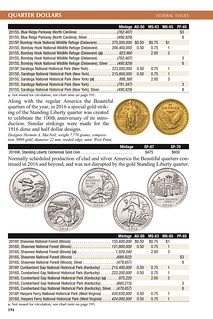 “The United States Mint continues to innovate with creative new coin designs, as well as updating its ongoing coinage,” said Whitman publisher Dennis Tucker. “The new Red Book contains the most recent Lincoln cents, Jefferson nickels, Roosevelt dimes, America the Beautiful quarters, Kennedy half dollars, Native American dollars, commemoratives, official Mint coin sets, and bullion coins.”
“The United States Mint continues to innovate with creative new coin designs, as well as updating its ongoing coinage,” said Whitman publisher Dennis Tucker. “The new Red Book contains the most recent Lincoln cents, Jefferson nickels, Roosevelt dimes, America the Beautiful quarters, Kennedy half dollars, Native American dollars, commemoratives, official Mint coin sets, and bullion coins.”
The 71st-edition Red Book includes the new 2017-P Lincoln cents, struck in Philadelphia with a “P” mintmark (the first ever on a one-cent coin) to honor the 225th anniversary of coinage there. The book also includes the final issues of the Presidential dollar program: Richard Nixon, Gerald Ford, and Ronald Reagan. Special coverage is given to the 1916–2016 gold Mercury dimes, Standing Liberty quarters, and Liberty Walking half dollars, and to the Mint’s new program of High Relief American Liberty $100 gold coins.
The 71st edition covers 94 additional new issues compared to the 70th edition, and 11 new coin sets. Mintages have been updated across the board using the latest numismatic research and government data. Data and information on modern Satin Finish coins have been revised and updated.
The 71st edition continues a section that debuted last year, covering foreign coins that circulated as legal tender in the British American colonies and early United States. This section includes photographs, history, and pricing for collectible Spanish-American, Dutch, French, and English coins dating from the 1550s to the 1820s.
Expansions and updates are also seen in the appendices. The appendix on modern U.S. Mint gold and silver medals lists more than 30 medals and sets, now including the Young Astronauts medals, Benjamin Franklin Firefighters medal, 9/11 silver medal, and others.
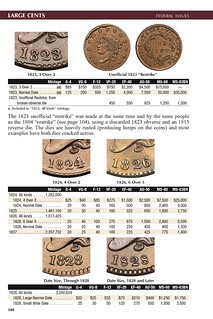

As in past years, collectors will benefit from the Red Book’s recent auction records provided for significant rare coins. Listed throughout the charts are 194 notable auction results. Combined with the listed retail prices, the auction data help advanced collectors understand the modern market for high-end rarities.
In addition, the appendix of the “Top 250 U.S. Coin Prices Realized at Auction” has been fully updated. Since the last edition 3 more coins have broken the $1 million mark, for a new total of 93. The coin at #250, a High Relief, Wire Rim, MCMVII (1907) $20 gold double eagle, sold for $27,050 more than #250 in last year’s edition.
In a positive measure of the health of the hobby and ongoing numismatic research, the Red Book’s bibliography includes 29 standard references published within the past five years.
The cover of the spiral-bound 71st edition shows three classic American coins: a 1787 Fugio copper, a Barber half dollar, and a Liberty Head $20 double eagle.
Research Editor Q. David Bowers calls the Red Book “a one-book numismatic library.”
All versions and formats of the 71st-edition Red Book will be available at its national debut at the Whitman Publishing booth during the Baltimore Expo, March 30–April 2, 2017, at the Baltimore Convention Center.
A Guide Book of United States Coins, 71st edition
464 pages
Full color
By R.S. Yeoman; senior editor Kenneth Bressett; research editor Q. David Bowers;
valuations editor Jeff Garrett
$15.95 spiralbound
$17.95 hardcover
$19.95 spiralbound hardcover
$29.95 Large Print Edition
$49.95 expanded Deluxe Edition (1,504 pages)
$99.95 leather-bound Limited Edition (250 copies)
For more information, or to order, see:
www.whitman.com
NEW BOOK: IMAGES OF VALUE
U.S. Security Engraving 1830s-1980s
at the Grolier Club
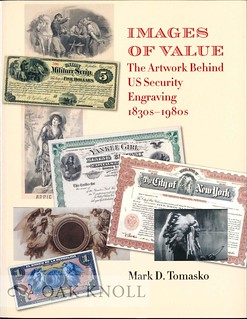 The paper money we handle every day depicts familiar portraits of presidents
and statesmen, but how many people know that a woman's portrait was once a standard
likeness on federal currency? Or that a notorious showgirl's portrait was engraved for
bond coupons? Or that a portrait of one of Queen Victoria's daughters was turned into
"Young America" for use on stock certificates? The exhibition Images of Value: The
Artwork Behind U.S. Security Engraving 1830s-1980s, on public view at the Grolier
Club from February 22 to April 29, 2017, presents a rare look behind the images that
appeared on bank notes and securities produced in the United States for over 150 years.
The paper money we handle every day depicts familiar portraits of presidents
and statesmen, but how many people know that a woman's portrait was once a standard
likeness on federal currency? Or that a notorious showgirl's portrait was engraved for
bond coupons? Or that a portrait of one of Queen Victoria's daughters was turned into
"Young America" for use on stock certificates? The exhibition Images of Value: The
Artwork Behind U.S. Security Engraving 1830s-1980s, on public view at the Grolier
Club from February 22 to April 29, 2017, presents a rare look behind the images that
appeared on bank notes and securities produced in the United States for over 150 years.
For the first time visitors can see a remarkable range of original wash drawings and paintings, period photographs and prints used to engrave the images on documents of value for the United States and countries ranging from Argentina to China to Spain, along with the documents on which the resulting engravings appeared. The exhibition is primarily from the holdings of Mark D. Tomasko, a private collector, scholar, and researcher who documents the engravers, artists, designers, and bank note firms.
Much news has been made in recent months about portraits of women coming to U.S. federal paper money, but in reality it’s a case of women coming back to federal paper money. Martha Washington’s portrait was a constant presence on US Silver Certificates from 1886 to the turn-of-the-century, and possible sources for the image used are on display along with the Silver Certificates on which she appeared.
Before the Civil War banks were chartered by the states, and most local banks issued their own bank notes. This created a large demand for quality paper money and gave rise to a thriving group of bank note engraving firms, effectively making the U.S. the world leader in security engraving by the late 1850s.
Exquisite miniature drawings by Asher B. Durand, George W. Hatch, Henry Inman, and Thomas Birch illustrate the era when artwork needed to be drawn in a very small size to be engraved. Photography later liberated the artwork from the miniature size (the art could be photo-reduced to the size to be engraved). The result was the golden age of wash drawings, 1850s-1870s, with marvelous allegorical and genre drawings by American artists including the outstanding F. O. C. Darley, whose drawings of the American scene set a high standard. Featured in the exhibition are Darley's drawings of Union Civil War soldiers, and some of his genre subjects. Other noted artists shown for this era include James D. Smillie and Walter Shirlaw.
American and European prints of the mid- and late-nineteenth century include several remarkable mid-century French chromolithographs of female heads, an art engraving of one of Queen Victoria’s daughters (turned into a security engraving entitled “Young America”!), a large theater poster, and a large print of Rosa Bonheur’s Horse Fair (one of the largest paintings in the Metropolitan Museum of Art, at 8’ x 16’). Horse Fair became an engraving 1 1⁄2” x 3 1⁄2” and was used on documents as diverse as an 1870s Bolivian bank note and an 1880s New York City street railway bond.
By the twentieth century photographs became more commonly used as the artwork source for bank note picture engravings. On view are photographs of Chinese subjects turned into engravings on bank notes for China but produced by American bank note firms. Other period photos used for engravings include a large panorama of Lower Manhattan in 1904 and a portrait of Evelyn Nesbit, the “girl in the red velvet swing” who became a decorative engraving for coupon bonds.
Alonzo E. Foringer, a muralist who had worked for Edwin Blashfield, is a star of the show, with his large oil paintings of allegorical females produced from the 1910s to the 1940s. The finest picture engravers created the best allegorical engravings of the twentieth century from Foringer’s work, a marriage of engraving and art that has never been equaled. Known today primarily for a World War I Red Cross poster, Foringer’s real achievement is his bank note art, which graced the stocks and bonds of hundreds of U.S. companies and at least 50 bank notes of foreign banks and governments.
Robert Lavin followed Foringer and became the second greatest security engraving artist of the twentieth century, working in the 1960s-1980s. His allegorical paintings, and paintings of working people (perhaps best described as “Capitalist Realism”), became the leading picture engravings for stocks and bonds in the later twentieth century. Some examples of other artists’ work of the 1950s and 1960s are also shown in the exhibition.
CATALOGUE:
The exhibition Images of Value: the Artwork Behind U.S. Security Engraving 1830s-
1980s, sponsored by the Grolier Club’s Committee on Prints, Drawings, and
Photographs, is accompanied by a full-color catalogue with a preface by William H. Gerdts.
PUBLIC EVENTS:
Free Lunchtime Exhibition Tours led by curator Mark Tomasko: February 22, March 1, 8,
15, 22, and 29, 1:00 pm - 2:00 pm.
Illustrated Talk by the curator followed by a Panel Discussion on the Artwork Behind U.S. Security Engraving: Tuesday, March 7, 2017, 3:00 pm - 5:00 pm.
ABOUT THE GROLIER CLUB:
Founded in 1884, the Grolier Club of New York is America’s oldest and largest society for
bibliophiles and enthusiasts in the graphic arts. Named for Jean Grolier, the Renaissance
collector renowned for sharing his library with friends, the Grolier Club’s objective is to foster the
study, collecting, and appreciation of books and works on paper.
VISITING THE GROLIER CLUB:
47 E. 60th Street,
New York, NY 10022
212-838-6690
Hours: Monday-Saturday, 10 AM to 5 PM
Admission: Open to the public free of charge
www.grolierclub.org
Mark Tomasko adds:
It's an unusual exhibition, as I don't believe there has been another one like it, showing 150 years of prints, drawings, photographs, and paintings used for security engraving. There are over 250 items in the show, mostly in groups of three, namely (a) the artwork; (b) a die proof of the engraving; and (c) one or more documents of value (bank notes or securities, mostly) on which the engraving was used.
There is a 173 page catalogue, with most everything illustrated, in color, available for purchase at the Club or by mail from Oak Knoll Books, for $40. Every copy has an intaglio print as the frontispiece, of the signature image of the show, "Abundance," a painting by A. E. Foringer done in 1927 for American Bank Note.
 IMAGES OF VALUE: THE ARTWORK BEHIND US SECURITY ENGRAVING · 1830s-1980s.
IMAGES OF VALUE: THE ARTWORK BEHIND US SECURITY ENGRAVING · 1830s-1980s.
Tomasko, Mark D.
New York, NY: The Grolier Club, 2017.
8.5 x 11 inches
Paperback with flaps
174 pages
ISBN: 9781605830674
Price: $40.00
For more information, or to order, see:
IMAGES OF VALUE: THE ARTWORK BEHIND US SECURITY ENGRAVING · 1830s-1980s. - See more at: https://www.oakknoll.com/pages/books/129450/mark-d-tomasko/images-of-value-the-artwork-behind-us-security-engraving-1830s-1980s#sthash.TZ89Cpmj.dpuf
(www.oakknoll.com/pages/books/129450/mark-d-tomasko/images-of-value-the-artwork-behind-us-security-engraving-1830s-1980s)

MERCANTI TO RECIEVE DAVID RITTENHOUSE AWARD
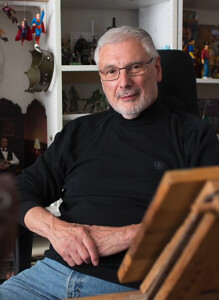 The board of directors of Historic Rittenhouse Town, located in Fairmount Park, Philadelphia, will award the 2017 David Rittenhouse Award to John Mercanti at its annual gala in May. “The David Rittenhouse Award honors those who demonstrate excellence as it represents one of the many contributions that Rittenhouse made to American History,” said Barbara Rittenhouse, board president. “David Rittenhouse was an amazing man. In his lifetime, he was an astronomer, inventor, mathematician, surveyor, and the successor to Benjamin Franklin as president of the American Philosophical Society. We reserve this prestigious award for those who’ve contributed their talents at the highest level to our nation.”
The board of directors of Historic Rittenhouse Town, located in Fairmount Park, Philadelphia, will award the 2017 David Rittenhouse Award to John Mercanti at its annual gala in May. “The David Rittenhouse Award honors those who demonstrate excellence as it represents one of the many contributions that Rittenhouse made to American History,” said Barbara Rittenhouse, board president. “David Rittenhouse was an amazing man. In his lifetime, he was an astronomer, inventor, mathematician, surveyor, and the successor to Benjamin Franklin as president of the American Philosophical Society. We reserve this prestigious award for those who’ve contributed their talents at the highest level to our nation.”
John Mercanti produced more coin and medal designs than any other employee in the history of the U.S. Mint. He designed the American Eagle platinum obverse and silver reverse; the 50 State Quarters reverses for South Dakota (2006), West Virginia (2005), Iowa (2004), Arkansas (2003), Louisiana (2002), North Carolina (2001), and Pennsylvania (1999), and the following commemoratives:
-
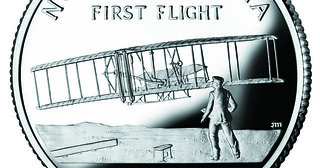 1984 Olympics gold $10 obverse and reverse
1984 Olympics gold $10 obverse and reverse
- 1986 U.S. Statue of Liberty silver $1 obverse
- 1989 U.S. Congress Bicentennial gold $5 obverse and reverse
- 1990 Eisenhower Centennial silver $1 obverse
- 1991 Mount Rushmore Golden Anniversary gold $5 reverse
- 1991 Korean War Memorial silver $1 obverse
- 1991 USO 50th Anniversary silver $1 reverse
- 1992 Christopher Columbus Quincentenary silver $1 obverse
- 1994 Vietnam War Memorial silver $1 obverse
- 1994 Bicentennial of the U.S. Capitol silver $1 reverse
- 1995 Centennial Olympics silver $1, Cycling obverse, Track & Field obverse
- 1995 Civil War Battlefield silver $1 reverse
- 1996 Smithsonian 150th Anniversary silver $1 reverse
- 1998 Black Revolutionary War Patriots silver $1 obverse
- 2000 Library of Congress bimetallic $10 obverse and silver $1 reverse
- 2000 Leif Ericson silver $1 obverse
- 2001 U.S. Capitol Visitor Center silver $1 reverse
- 2002 Olympic Winter Games silver $1 obverse
- 2002 West Point Bicentennial silver $1 obverse
- 2003 First Flight Centennial 50c obverse
- 2004 Thomas Alva Edison silver $1 reverse
- 2005 Chief Justice John Marshall $1 silver obverse
- 2007 Jamestown 400th anniversary $5 gold obverse
He is also the designer of the Perth Mint’s successful wedge-tailed eagle bullion series (which are sold directly by the Perth Mint as well as by third-party vendors like APMEX).
Born in Philadelphia, Mercanti received his artistic training at the Pennsylvania Academy of Fine Arts, the Philadelphia College of Arts, and the Fleisher Art Memorial School.
Previous recipients of the David Rittenhouse Award have included Derrick Pitts, chief astronomer and planetarium director of the Franklin Institute; Keith Thompson, executive officer of the American Philosophical Society; and Owen Gingrich, professor emeritus of astronomy and of the history of science at Harvard University and a senior astronomer emeritus at the Smithsonian Astrophysical Observatory.
The award will be part of a year-long celebration of the 225th anniversary of David Rittenhouse’s being named the first director of the U.S. Mint. (This anniversary, naturally, parallels the Mint’s own 225th anniversary; Historic RittenhouseTown, however, is a separate entity.) It will be presented to Mr. Mercanti on May 17, 2017, for his decades of service and outstanding work as the 12th chief engraver/sculptor of the United States Mint.
To read the complete article, see:
2017 David Rittenhouse Award to honor John Mercanti, 12th chief engraver/sculptor of the Mint
(http://news.coinupdate.com/2017-david-rittenhouse-award-to-honor-john-mercanti-12th-chief-engraversculptor-of-the-mint/)

The 2017 David Rittenhouse Award Dinner honors John Mercanti, former Chief Engraver and Sculptor of The United States Mint.
VIP ticket: $195 Includes VIP cocktail reception, dinner and early access to the silent auction
Regular ticket: $145 Includes dinner and silent auction
To read the complete article, see:
http://rittenhousetown.org/special-events/
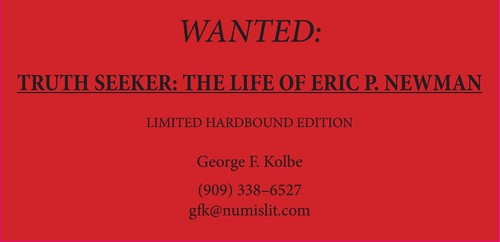
A MINT CHIP IN THE NEWMAN COLLECTION


Digitization of the Eric P. Newman correspondence files continues apace, with correspondents through the letter “J” now posted on the Newman Portal. In processing the letter K, we came upon an interesting letter of acknowledgement from Newman to Alexander Kaptik, who in 1966 donated to the Eric P. Newman Numismatic Education Society a specimen of timber recovered from the demolition of the first United States Mint in 1911.
Newman writes in part “We are simply delighted…It is one of those strange replicas which brings a nostalgic feeling to everyone in numismatics. It must be a wish that they could have been there to witness the operations. This piece of timber saw some beautiful coinage and witnessed brutal toil which went into its production.”
Kaptik was active in the Philadelphia Coin Club, bourse chairman of the 1957 Philadelphia ANA, and served on the Assay Commission in 1965. Kaptik likely received this piece from George Cucore, a fellow Philadelphia Coin Club member, as detailed in Secret History of the First United States Mint (Whitman Publishing, 2011), pp. 80-85.
Link to Newman correspondence on the Newman Portal:
https://nnp.wustl.edu/Library/Archives?searchLetter=E
IMPERFECT COINS SOUGHT FOR WHITMAN PROJECT

Whitman Publishing is looking for sharp, high-resolution photographs or scans of “problem” coins to illustrate in upcoming books. Hobbyists who share their images will be credited in the books’ acknowledgments.
“Most of the time we show Mint State pieces with strong details, to give our readers a good understanding of each coin type or die variety,” said Whitman publisher Dennis Tucker. “But coins with problems can be educational, too.”
The publishing firm is looking for coins with: PVC damage; bag marks; scratches; edge bumps, nicks, or dents; holes; or extreme wear.
Image files should be at least 300 dpi at two times actual size. Scans and cell-phone photographs are acceptable as long as the image is high-resolution and clearly illustrates the coin’s problem.
Collectors with images to share can contact Dennis Tucker at dennis.tucker@whitman.com.
To read the complete article, see:
Whitman Publishing Wants Your Imperfect Coins
(http://news.coinupdate.com/whitman-publishing-wants-your-imperfect-coins/)

NOTES FROM E-SYLUM READERS: FEBRUARY 26, 2017
Ordering Lunch at the Old Treasury Vault
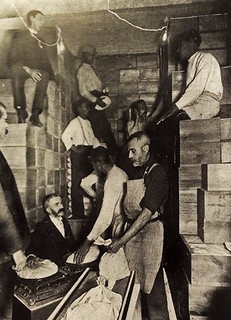 Eric Hodge writes:
Eric Hodge writes:
I thank you, once again, for an informative and thought provoking weekly numismatic update. The item that attracted my attention was the second photograph in the Old U.S. Treasury Vault article. Is the gentleman standing right at the back using a mobile phone?
To read the earlier E-Sylum article, see:
THE OLD U.S. TREASURY VAULT
(www.coinbooks.org/v20/esylum_v20n08a22.html)
More On One-Cent Checks
Jeffrey Zarit writes:
When I moved from Chicago to Dallas in 1980, Illinois Bell Telephone sent me a one cent check that has been on the wall of my office ever since.
And I stayed at the Sheraton in Mexico City many years ago and complained about the telephone charges that were charged. They sent me a check for 50 cents (25 cents a day) for my stay there and that check is also framed with the above one cent check.
Another reader writes:
I used to write one-cent checks as payment for credit card accounts. These were additional payments, after I had already made a payment in the minimum amount (or more). Reason I did this was twofold:
1) as a protest against the bank's high interest charges, by adding to their expense by making them process a check for one cent (and yes, they DID process them!).
2) This was back when the banks actually returned cancelled checks, so I figured/fantasized that if I ever got famous I'd have additional signed checks that I could sell to fans and collectors. Hey, a guy can dream, right?
To read the earlier E-Sylum article, see:
NOTES FROM E-SYLUM READERS: FEBRUARY 19, 2017 : One-Cent Checks
(www.coinbooks.org/v20/club_nbs_esylum_v20n08.html)
More on Withdrawn Coins
David Pickup writes:
Last minted in 1956 the farthing was not demonetised until 31 December 1960, when they ceased to be legal tender.
Decimal Day was 15 February 1971 but many coins were not withdrawn for years. Sixpences were last minted in 1967 but were not withdrawn until 30 June 1980. These coins were favourites with the public and there was a strong attachment to them. I suspect there will be a similar reluctance to withdraw the penny if that happens.
To read the earlier E-Sylum article, see:
'ROUND POUND' TO BE RETIRED OCTOBER 15, 2017
(www.coinbooks.org/v20/esylum_v20n08a27.html)
Bear Island, Norway
Last week I asked for more information about Bear Island, the location of this note from the Lyn Knight sale.

Dave Ellison writes:
Bear Island is the southernmost island of the Norwegian Svalbard archipelago. The island is located in the western part of the Barents Sea, approximately halfway between Spitzbergen and North Cape, Norway. The whole island was privately owned by the coal mining company Bjornoen AS from 1918 to 1932, when the Norwegian state took over the shares. The note dates from this period of economic activity.
Bear Island (Norway) (https://en.wikipedia.org/wiki/Bear_Island_(Norway))
Bjørnøen (https://en.wikipedia.org/wiki/Bj%C3%B8rn%C3%B8en)
To read the earlier E-Sylum article, see:
SELECTIONS FROM THE KNIGHT 2017 PCDA SALE
(www.coinbooks.org/v20/esylum_v20n08a19.html)
More On Grading Paper Money
Ron Thompson of
Decatur, GA writes:
I enjoyed and can relate to David Gladfelter’s comments on grading paper money. However, I can also empathize with the grading services a bit.
All grading is subjective so I would say to look at the item in the holder and not the grade on it when making a purchase decision. With that in mind, the more similar items you have graded the more consistency can be achieved in grading standards. Today billions of coins are being pumped out by the various mints. The biggest problem with these might be the tug between technical and market grading. Going back in time there were fewer coins produced that have survived and many different techniques used to produce them so more flexibility in what is graded for those coins would be expected. Similar points could be made for paper money, however, paper money is a relative new comer, both to the world and to grading so there may be a learning curve here.
Surviving U. S. paper money and documents from prior to and even during the Civil War could be far fewer than similar coin items and even if they survive they are more fragile. Survivability of paper money is also impacted by the fact that there is no underlining silver or gold value once the paper money is no longer honored. The result is that there are more problems (stains, pin holes, corner clips, uneven cuts, etc.) with generally limited surviving paper money and documents. This fragility has led some collectors and the grading services to encapsulate items that might not otherwise be encapsulated and graded. I have seen several items encapsulated by PCGS without grades presumably to protect them.
There is also another factor at play here, knowledge. There is a large amount of literature available on coins from ancient times to today. Thus expertise can and is developed quicker and easier for the coin collectors and graders than for paper money collectors and graders. Finding literature on many paper money series is relatively hard and expensive. Only in this century has the literature gap begun to be addressed. Newman issued his “vastly improved” (his opinion) fifth edition of The Early Paper Money in America in 2008. Whitman has started to update Haxby’s four volume set of Standard Catalog of United States Obsolete Bank Notes 1782-1866 (1988 – poor quality pictures) in 2014 with a projected 13(?) volume set (roughly $50-$60 a volume) of Whitman Encyclopedia of Obsolete Paper Money. These two cover continental & colonial and non-Federal obsolete bank issues only.
There are a number of insurance, mining, railroad, turnpike, merchant and other issues and lots of local scrip issues not covered by these references. This means you have to hunt for almost always out-of-print limited editions for a specify area or series, if there is something written on them. The Society of Paper Money Collectors has tried to address this by issuing a number of books on obsolete currencies by state but some need updating and others need to be issued. Presumably the grading services have extensive libraries to consult but graders need to learn and absorb this information before grading paper money. The graders always seem to be good at the grades, but not so much on the identification, variety and other factors. I suspect some are involved in OJT like we learned about some of the graders for medals. I have resubmitted and gotten corrections at no cost on paper money items I thought they have done a poor job with the identification/variety.
Bottom line, I would rather see a questionable item encapsulated with the appropriate comments on the front or reverse, rather than have the item rejected.
To read the earlier E-Sylum article, see:
NOTES FROM E-SYLUM READERS: FEBRUARY 19, 2017 : On Grading Services
(www.coinbooks.org/v20/esylum_v20n08a12.html)
More on the Puffin Coinage of Lundy
Regarding the Puffin Coinage of Lundy,
Ron Haller-Williams writes:
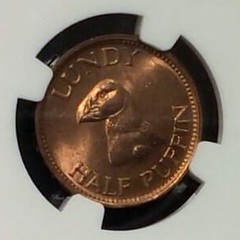 I'm surprised that the original Coin World article (and The E-Sylum item) did not picked up on these points:
I'm surprised that the original Coin World article (and The E-Sylum item) did not picked up on these points:
(a) Harman was charged with contravening Section 5 of the Coinage Act of 1870, though this is briefly mentioned in the video, and the last few words of the Coin World headline hint at it: "(well, maybe not legally)".
He appealed from the verdict of the Petty Sessions (i.e. Magistrates' Court), to the High Court of Justice, where he also lost and was fined £5, with fifteen guineas (£15 15s) costs.
(b) There have been restrikes dated 1965 (by John Pinches), 1977 (by Coincraft?) and 2011. The 1929 originals have the edge inscription "LUNDY LIGHTS AND LEADS", while the others (and some patterns of 1929) have plain edges, except for a reeded edge on the 2011 6-puffin coin.
By the way, you faithfully reproduce the CoinWorld typo: Harmon for Harman in "“Harmon ordered 50,000 ..."
The video soundtrack states that the puffin was halfpenny sized and the half puffin was the size of a farthing – this is accurate only with reference to the pre-1860 copper coins. See https://en.wikipedia.org/wiki/Coins_of_Lundy
https://www.coincraft.com/1977-jubilee-lundy-set twice shows the wrong original date (1928), and states that the 1965 sets were by the Franklin mint. It also states that the Coinage Act case went to the House of Lords – as does https://en.wikipedia.org/wiki/Martin_Coles_Harman
Even without the legal hassle, Harman could not have made much from this enterprise (unless he envisaged selling some later, at a premium) - just £19 7s 6d on an outlay of £293 2s 6d, by my reckoning, for coins with a face value of £312 10s; that's ignoring postage, letters and presumably phone calls – plus the overheads of accounting for the things!
I had thought (obviously wrongly) that the edge inscription was the only feature which differentiated the 1965 issues from the 1929 ones.
To read the earlier E-Sylum article, see:
THE PRIVATE PUFFIN COINAGE OF LUNDY
(www.coinbooks.org/v20/esylum_v20n08a26.html)
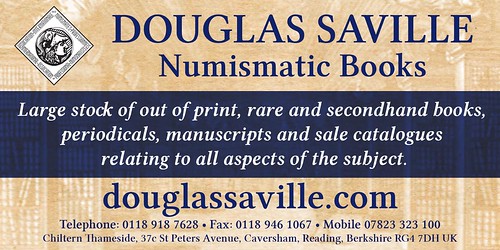
PROFESSOR HELLMANN'S 1970S TEST NOTES
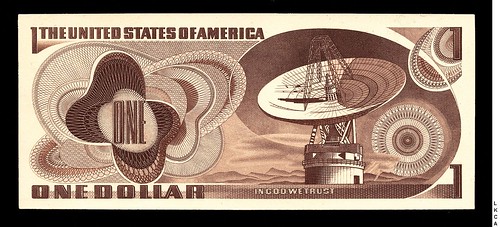
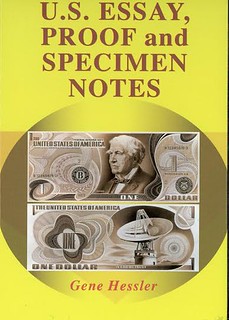 [The late] Professor Roman Hellmann [who was the designer at the National Bank of Austria] had a close working relationship with Gualtiero Giori at De La Rue Giori in Switzerland. In 1971 when a particular printing press was in the development stage, Mr. Giori asked Professor Hellmann to design some notes to be printed when the press was ready. "The pioneering type of printing that Mr. Gori intended to create was called multi-intaglio or "'Orlof intaglio.'"
[The late] Professor Roman Hellmann [who was the designer at the National Bank of Austria] had a close working relationship with Gualtiero Giori at De La Rue Giori in Switzerland. In 1971 when a particular printing press was in the development stage, Mr. Giori asked Professor Hellmann to design some notes to be printed when the press was ready. "The pioneering type of printing that Mr. Gori intended to create was called multi-intaglio or "'Orlof intaglio.'"
In 1970, during a visit to De La Rue Giori, Professor Hellmann met Director Conlon of the U.S. Bureau of Engraving and printing (1967-1977). Subsequently Professor Hellmann created two U.S. designs in a water color technique. One of them was in the conventional genre of the U.S. dollar but with greatly improved security devices. Sample prints were not possible, as the Orlof intaglio printing press would not be in existence until 1998. Both essays are identified on the face as Series 1970B. (Professor Hellmann sent this information to me. For his biography see The International Engraver's Line.)
Gene adds:
The back design, shown in The E-Sylum, with a parabolic reflector symbolizes the modern development trends in Edison's telegraphy, according to Professor Hellmann.
When I attended the Memphis show about ten years ago someone had an example of this back design. It was neither engraved nor embossed but printed by thermography, a printing method that poorly simulates intaglio. The source is unknown to me, even though the Knight catalog states Norway.
To read the earlier E-Sylum article, see:
SELECTIONS FROM THE KNIGHT 2017 PCDA SALE : Lot 616 U.S. Test Proof Note One Dollar
(www.coinbooks.org/v20/esylum_v20n08a19.html)
THE BOOK BAZARRE
WHAT THE NOBEL PEACE PRIZE MEDAL LOOKS LIKE
I saw your note on the upcoming Nobel Peace Prize sale . You mention the reverse isn’t shown. Well, unless I’m missing something, the obverse in the PR release isn’t even of a Peace Medal. That’s the Erik Lindberg portrait which was used on the Literature, Medicine, and Physics and Chemistry medals.
The designs for the Peace Prize were awarded to the Oslo-based sculptor Gustav Vigeland (1867–1943). I think it was the only medal he ever designed, and since he was not a medallist the reductions were done by Lindberg.
 Here’s what the Peace medal portrait looks like.
Not as familiar as Lindberg’s.
Here’s what the Peace medal portrait looks like.
Not as familiar as Lindberg’s.
For more information on the Nobel Peace Prize, see:
http://www.nobelprize.org/nobel_prizes/peace/
To read the earlier E-Sylum article, see:
CHRISTIE’S TO OFFER NOBEL PEACE PRIZE MEDAL
(www.coinbooks.org/v20/esylum_v20n08a28.html)
COLONIAL ARCHAEOLOGIST NOëL HUME
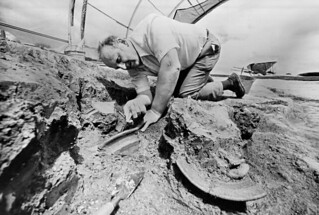 Ivor Noël Hume, an accidental, self-taught English-born archaeologist who unearthed the earliest extensive traces of British colonial America, a town that had vanished after a massacre almost 350 years earlier, died on Feb. 4 at his home in Williamsburg, Va. He was 89.
Ivor Noël Hume, an accidental, self-taught English-born archaeologist who unearthed the earliest extensive traces of British colonial America, a town that had vanished after a massacre almost 350 years earlier, died on Feb. 4 at his home in Williamsburg, Va. He was 89.
In 1970, as the director of archaeology at Colonial Williamsburg, Mr. Noël Hume was searching in the ruins of Carter’s Grove, a nearby 17th-century plantation along the James River, when he and his colleagues discovered the remains of a once-fortified settlement called Wolstenholme Towne.
The site was founded in 1619 by 220 men and women who had arrived on the vessel Gift of God to establish a plantation for the Virginia Company of London. The settlement, named for John Wolstenholme, a prominent company shareholder, was about nine miles downstream from Jamestown, where colonists had first landed 12 years before.
As the head of archaeology at Williamsburg and an author of ultimately more than two dozen books, Mr. Noël Hume endowed the unvarnished artifacts he unearthed with a social and economic perspective.
The newspaper Antiques and the Arts Weekly recently credited his books, lectures and television presentations with propelling the field of historical archaeology “to the forefront of his profession.”
Reviewing his book “The Virginia Adventure,” the historian Arthur Quinn wrote in The New York Times Book Review in 1994 that Mr. Noël Hume “will charm the mute artifacts into speaking about subjects on which the written record has preferred to remain silent.”
Mr. Noël Hume, who had been fascinated by artifacts since he received a gift of ancient Greek coins as a child but who did not have a degree in archaeology, proudly considered himself to be a historical detective.
“Historical archaeology,” he wrote, “simply means hunting for physical evidence and reviewing it alongside the testimony of people who knew or saw what happened.”
To read the complete article, see:
Ivor Noël Hume, Archaeologist of Colonial America, Dies at 89
(www.nytimes.com/2017/02/19/us/ivor-noel-hume-dead-archaeologist-colonial-williamsburg.html)
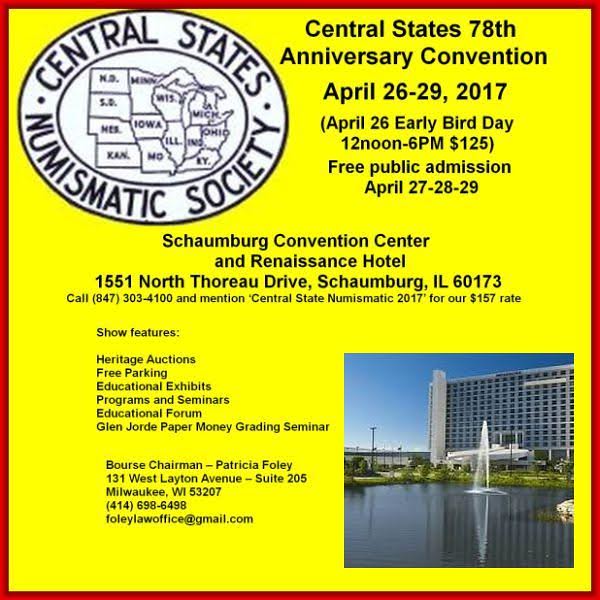
VOCABULARY TERM: OVAL MEDAL
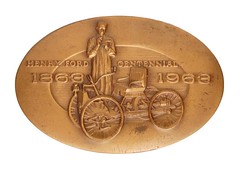
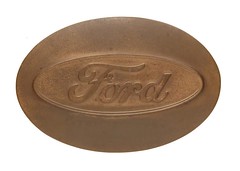
Reason for this Henry Ford Centennial Medal, 1963, was obvious for the oval Ford trademark or logo. Sculptor Ralph Menconi created an attractive oval obverse in horizontal format. Vertical oval medals are somewhat more common making this medal more distinctive.
Oval Medal. An ellipsoidal shaped medal. This UNUSUAL SHAPE is aesthetically pleasing, more so if the oval shape is meaningful to the subject or topic of the medal, as an oval halo of a religious medal. Struck oval medals are created by striking within special COLLARS, or by the use of special TRIMMING DIES; cast medals can easily be made in oval shape. Among oval medals vertical ovals are slightly more popular than horizontal. Most CAMEO medals are likely oval in shape; oval medals makes excellent pendant medals.
Oval die problem. Oval medals present somewhat of a problem to the diesinker, engraver or sculptor not present in round medals, in that the shape of the obverse must exactly match that of the reverse (the contour of the oval is not too round or too narrow). This can easily be resolved in modeling by preparing two BACKGROUND PLATES or basins of the exact congruent and matching shape before building up the relief. See MODELING.
Oval Indian Peace medals. The first American Indian Peace Medals, bearing the standing figure of George Washington, were all oval shaped. These hand engraved medals were probably designed this way for their intended purpose of being pendants to be worn by American Indian chiefs as recipients.
Beginning in 1879, when the United States Mint created a series of struck Indian Peace Medals, five of these retained the oval shape (IP-43 through IP-47). All others in the series were round. The oval shape required all pieces to be struck with oval collar dies used with oval collars (an innovation of the U.S. Mint in 1879).
Modified ovals. If a vertical oval has one pointed end, shaped like an almond, it is called a MANDORLA. If it has two pointed ends, it has a name in Latin, vesica piscis. Both of these oval shapes are symbolic for saints, the Virgin Mary, or other religious themes.
Some oval medals were created with a separate wreath usually attached to it afterwards; this was often done in Latin American countries. These were enclosed with a SURROUND, the separate wreath was not in the die but soldered to the medal after both were struck. Oval medals made as pendants and given to wedding guests in 17th century Germany were called gnadenpfennig.
CLASS 02.13
RALPH RANDOLPH BARKER (1856-1913)
 Ralph Randolph Barker (1856-1913), was born on February 12, 1856, at Newport, Rhode Island, son of George Clarke Barker (1833-1903) and Mary Jane Chace Barker (1836-1866). He attended public school at Newport graduating in 1873. He entered his father's firm dealing in paint and home decorating. In 1877, his father made him a partner in the firm and changed the name to George C. Barker & Son.
Ralph Randolph Barker (1856-1913), was born on February 12, 1856, at Newport, Rhode Island, son of George Clarke Barker (1833-1903) and Mary Jane Chace Barker (1836-1866). He attended public school at Newport graduating in 1873. He entered his father's firm dealing in paint and home decorating. In 1877, his father made him a partner in the firm and changed the name to George C. Barker & Son.
Ralph Randolph Barker, ANA Member No. 41, is a mysterious figure in American numismatic history counted among the notable numismatists of Newport that included : Windfield Scott Sisson, Dr. Horatio R. Storer, Russell, and Edwin P. Robinson. Most American numismatists do not know who he was and are therefore uneasy when they come across anything bearing his name. Consequently it is not uncommon to find him variously listed in American numismatic literature as Ralph Barker or R. R. Barker;
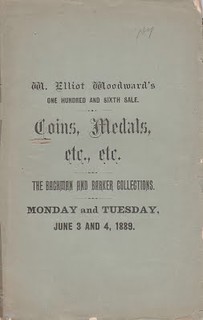 It is uncertain, though possible, that the Barker Collection sold June 3-4, 1889, catalogued by Ed Frossard for W. E. Woodward and sold at Davis & Harvey, Philadelphia, Pennsylvania, was that of the then thirty-three year-old Ralph R. Barker. There are two other equally viable candidates, however : L. C. Barker (ANA Member No. 123) of East Vassalboro, Maine, and Edward Barker (ANA Member No. 528) of Wakefield, Massachusetts. There, of course, may be a few others equally qualified to fit the criteria identifying them as this mysterious and rather ambiguous Barker whose collection Ed Frossard catalogued for Woodward who was too ill at that time. Where is the snarky loquacious Frossard with his commentary scattered throughout the catalogue when you need him most?!
It is uncertain, though possible, that the Barker Collection sold June 3-4, 1889, catalogued by Ed Frossard for W. E. Woodward and sold at Davis & Harvey, Philadelphia, Pennsylvania, was that of the then thirty-three year-old Ralph R. Barker. There are two other equally viable candidates, however : L. C. Barker (ANA Member No. 123) of East Vassalboro, Maine, and Edward Barker (ANA Member No. 528) of Wakefield, Massachusetts. There, of course, may be a few others equally qualified to fit the criteria identifying them as this mysterious and rather ambiguous Barker whose collection Ed Frossard catalogued for Woodward who was too ill at that time. Where is the snarky loquacious Frossard with his commentary scattered throughout the catalogue when you need him most?!
On June 22, 1880, he married Minerva "Minnie" Stone (1860-1945), daughter of Jason P. Stone and Sarah Wicks Stone, in Providence, Rhode Island. Minerva was a direct descendant of Job Matteson (1758-1809) of Rhode Island, who was at the siege of Boston and was captured at Fort Washington, 1776. They had three children : Ralph Randolph Barker, Jr. (1883-1948), Mabel Chace Barker (1891-1901), and Laura Stone Barker Seabury (1894-1983), who married Raymond M. Seabury (1890-1960).
There are ninety pieces of correspondence with the Chapman Brothers from Ralph Barker currently catalogued in the Lupia Numismatic Library.

In the August 1892 issue of The Numismatist Ralph R. Barker is listed as ANA Member No. 111.
Barker was a member of the Newport Coin and Medal Club. In the June/July 1897 issue of The Numismatist it was reported that Barker owned all three varieties of the Rhode Island Medal.
In the April 1902 issue of The Numismatist he is reported owning a near complete set of all the $3 gold pieces except that of 1875.
In 1903, after the death of his father he began to publish his business as George C. Barker & Son, Ralph R. Barker, successor.
He consigned to the Chapman Brothers for their coin auction sale held July 7-8, 1904 at Davis & Harvey, Philadelphia, containing a Chalmers shilling and sixpence, Washington pieces, Betts medals Nos. 603 & 604, and many U. S. and foreign coins with an emphasis on English coinage.
He was the treasurer of the Newport Historical Society, and a Trustee of the United Congressional Church. His interest in native Rhode Island Indians led him to become a director of the Miantinomi Club. He was the director of the National Exchange Bank, Newport, Rhode Island, and also of the Island Savings Bank. He served as president of the Builders' and Merchants' Exchange. He was a director of the YMCA.
He died by committing suicide inhaling illuminating gas on February 26, 1913, at Newport, Rhode Island. Nineteenth century houses were plumbed, i.e., fitted with pipes for the conveyance and distribution of illuminating gas into rooms and halls. Apparently, Barker extinguished the flame and kept the gas valve opened gassing himself in an enclosed room. His wife, who just returned from visiting relatives in Providence, Rhode Island, found him dead in her sewing room. He was 57 years old. The medical examiner, Charles W. Steward, expressed the opinion that a recent illness affected his mind. He is buried at the Island Cemetery, Newport, Rhode Island.
His estate consigned the remainder of his coin collection to Henry Chapman which was sold on November 28-29, 1913, with the combined collections of J. L. Heffner, H. C. Bowman, and a Chicago Amateur.
To read the complete article, see:
BARKER, RALPH RANDOLPH
(https://sites.google.com/a/numismaticmall.com/www/numismaticmall-com/barker-ralph-randolph)

REDFIELD HOARD HOUSE FOR SALE
Paul Williams of the Reno Coin Club, Nevada writes:
Check out this home I found on Zillow. This is the house where Lavere Redfield left his silver dollars in the basement.
 370 Mount Rose St,
Reno, NV 89509
4 beds 2 baths 3,788 sqft
370 Mount Rose St,
Reno, NV 89509
4 beds 2 baths 3,788 sqft
Back on Market! Historic Redfield Estate on the market for the first time since the 1930's, this eclectic home built entirely out of native Truckee Meadow's river stone is the largest of its kind in Northern Nevada. Immense history surrounds this prestigious property, owned by the prominent "Redfield" family since the 1930's. We are proud to deliver the home, inclusive with thorough cosmetic remediation throughout, while still retaining the original charm that makes this home one of a kind!
To read the complete listing, see:
370 Mount Rose St,
Reno, NV 89509
(www.zillow.com/homedetails/370-Mount-Rose-St-Reno-NV-89509/123654124_zpid/)
From the 2014 article about Redfield's biography:
For many years, rumors have persisted that the more than 400,000 silver dollars found hidden in Redfield's garage and mansion after his death were only a part of his treasure, that more might be buried elsewhere.
Harpster isn't so sure.
"Personally, I don't believe so," he said, but then added. "If the house ever gets torn down, I hope they do it carefully."
To read the earlier E-Sylum article, see:
NEW BOOK: LAVERE REDFIELD: SILVER DOLLAR KING
(www.coinbooks.org/esylum_v17n47a06.html)
For more on the Redfield hoard, see:
A History of Major U.S. Hoards: The Redfield Hoard
(www.pcgs.com/news/a-history-of-major-us-hoards-redfield-hoard/)

WHEN TIFFANY REDESIGNED THE GREAT SEAL
In the either-I-didn't-know-that-or-I-just-forgot department is this item on the time Tiffany & Company was called upon to redesign the Great Seal of the United States. An ad for the venerable firm in the February 22, 2017 Wall Street Journal caught my eye. A picture of a U.S. one dollar bill in a "T & CO" money clip has the headline text
"OLD MONEY
The official seal on the back of the United States one dollar bill was redesigned by Tiffany & Co. in the 1880s. We love making change."
An internet search found several references. Here's an excerpt from a history of the Great Seal from the web site of the U.S. State Department, with additional illustrations from GreatSeal.com. -Editor
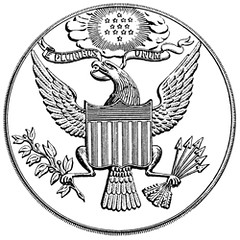
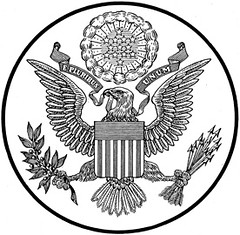
The 1877 and 1885 Designs
1877
With the celebration of the Centennial in 1876, Americans were reminded of their heritage, and interest was aroused in the origins and forms of the Great Seal. An article appeared in the press about this time revealing that there were “irregularities” in the 1841 die of the seal’s obverse and that the reverse, although created by law in 1782, had never been cut.
The Department of State seemed unaware of any public criticism, and the irregularities in the obverse were not corrected when the Throop die began to wear and a new die was cut during 1877. The engraver was Herman Baumgarten of Washington, DC, who followed the design of the 1841 die very closely, including the errors.
The seal was the same size as its two predecessors, but Baumgarten enlarged the stars and the lettering on the motto. It is considered the poorest of all the Great Seal dies, and, ironically, it was the one in use for the Great Seal’s own centennial in 1882.
1885
By early 1881, the Department of State responded to comments from the public and the press about the errors and omissions, and bids were asked for engraving a reverse and a
new obverse to correct them. The firm selected was Tiffany & Co. in New York, and its head designer, James Horton Whitehouse, was asked to submit sketches.
Whitehouse was a seal engraver, jewel cutter, and art designer of exceptional skill, taste, and artistic judgment. A great deal of research went into these two designs, going back to the original written description adopted in 1782. The Tiffany die of the obverse differs radically from all earlier dies. It is formal and heraldic, rather than realistic, and it served as the pattern for the die in use today. Its 3-inch diameter makes it larger than its predecessors, and the eagle once again carries 13 arrows. The olive branch has 13 leaves and 13 olives on it, and for the first time, the cloud of the crest is in the form of a complete circle.
But it is the eagle itself that has undergone the greatest change. Gone are the thin-kneed eagles with L-shaped legs, replaced by a muscular and unmistakably American bald eagle. More of the body appears above the shield, and the engraving is so skillfully done that the break between the white feathers of the head and neck and the dark feathers of the body is visible in both the die and the impressions. In another departure, the eagle grasps the olive branch and arrows in large, strong claws from behind, not from the front, as previously drawn.
Although a die for the reverse was ordered from Tiffany & Co. and funds were appropriated, the die was not cut. With the passing of pendant seals in 1871, there was no practical use for it.
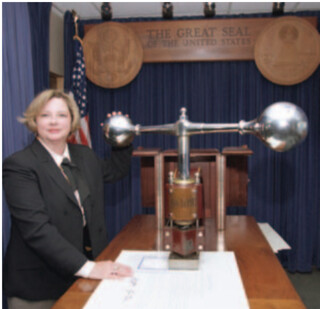 In the Department of State, the term
“Great Seal” has come to include not
just the die, but the counter-die, the
press, and the cover, or cabinet in
which it is housed, as well. These
stand in the Exhibit Hall of the
Department, inside a glass enclosure
which is kept locked at all times, even
during the sealing of a document.
In the Department of State, the term
“Great Seal” has come to include not
just the die, but the counter-die, the
press, and the cover, or cabinet in
which it is housed, as well. These
stand in the Exhibit Hall of the
Department, inside a glass enclosure
which is kept locked at all times, even
during the sealing of a document.
The mahogany cabinet’s doors also are kept locked, and the press is bolted and padlocked in position except when in use. The seal can be affixed only by an officer of the Department of State, under the authority of its custodian, the Secretary of State. When there are documents ready for sealing, one of the officers carries them to the enclosure where the Great Seal is kept and prepares them for impressing.
First, a 33 3/4-inch, scalloped, blank paper wafer of off-white linen stock is glued in the space provided for it to the left of the document’s dating clause. If ribbons are used in binding the document, they are run under the paper wafer and glued fast.
Second, the document is inserted between the counter-die, with the wafer carefully lined up between them.
Third, the document is held in place with the left hand and the weighted arm of the press is pulled sharply forward with the right hand, from right to left. This drives the die down onto the wafer, document, and counter-die, which impresses the seal in relief.
The die is then raised, releasing the document and allowing for its removal. When an envelope containing letters of credence or recall is to be sealed, the wafer is impressed first, and then glued to the sealed envelope, leaving the envelope itself unmarked.
To read the complete articles, see:
The Great Seal of the United States
(www.state.gov/documents/organization/27807.pdf)
Official Dies of the Great Seal of the United States
(http://greatseal.com/history/dies.html)
THE BOOK BAZARRE
1823 FIND OF OLD NEW JERSEY COPPER
Julia (Purdy) Casey of Charlton, New York. writes:
I found a few more articles in the old newspapers that may be some entertainment for the readers of The E-Sylum. These have to do with a New Jersey Copper found at a site in Augusta, Kentucky in 1823 .....and the confusion it caused!
Some things about this intrigued me: i.e. What was this site in Augusta, KY which was strewn with skeletons "of an unusual size"? Also, that New Jersey coins were still in circulation in 1823.
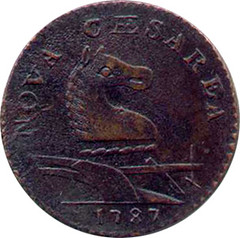

Natchez Gazette (Natchez, Mississippi)
February 22, 1823
Courtesy: Newspapers.com
A CURIOSITY
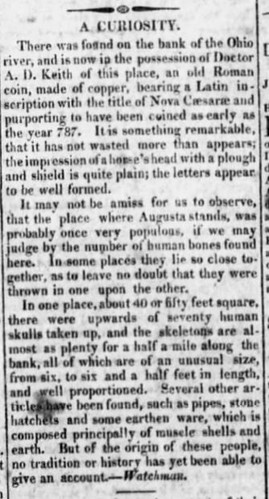 There was found on the bank of the Ohio
There was found on the bank of the Ohio
river, and is now in the possession of the Doctor
A.D. Keith of this place, an old Roman
coin, made of copper, bearing a Latin in-
scription with the title of Nova Caesarae and
purporting to have been coined as early as
the year 787. It is something remarkable
that it has not wasted more than appears;
the impression of a horse’s head with a plough
and shield is quite plain; the letters appear
to be well formed.
It may not be amiss for us to observe,
that the place where Augusta stands, was
probably once very populous, if we may
judge by the number of human bones found
here. In some places they lie so close to-
gether, as to leave no doubt that they were
thrown in one upon the other.
In one place, about 40 or fifty feet square,
there were upwards of seventy human
skulls taken up, and the skeletons are al-
most as plenty for a half a mile along the
bank, all of which are of an unusual size,
from six, to six and a half feet in length,
and well proportioned. Several other ar-
ticles have been found, such as pipes, stone
hatchets and some earthen ware, which is
composed principally of muscle shells and
earth. But of the origin of these people,
no tradition or history has yet been able to
give an account.--- Watchman
Hampden Journal & Advertiser (Springfield, Massachusetts)
April 30, 1823
(Courtesy: Genealogybank.com
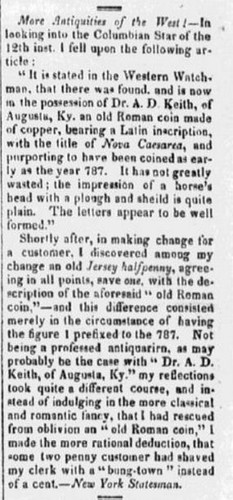 More Antiquities of the West - In
More Antiquities of the West - In
Looking into the Columbian Star of the
12th inst. I fell upon the following ar-
ticle:
“It is stated in the Western Watch-
man, that there was found, and is now
in the possession of Dr. A.D. Keith, of
Augusta, Ky. an old Roman coin made
of copper, bearing a Latin inscription,
with the title of Nova Caesarea, and
purporting to have been coined as ear-
ly as the year 787. It has not greatly
wasted; the impression of a horse’s
head with a plough and shield is quite
plain. The letters appear to be well formed.”
Shortly after, in making change for
a customer, I discovered among my
change an old Jersey halfpenny, agree-
ing in all points, save one, with the de-
scription of the aforesaid “old Roman
coin” - and this difference consisted
merely in the circumstance of having
the figure 1 prefixed to the 787. Not
being a professed antiquarian, as may
probably be the case with “Dr. A.D.
Keith, of Augusta, Ky.” my reflections
took quite a different course, and in-
stead of indulging in the more classical
and romantic fancy, that I had rescued
from oblivion and “old Roman coin,” I
made the more rational deduction, that
some two penny customer had shaved
my clerk with a “bung-town” instead
of a cent. - New York Statesman
Fredonian (New Brunswick, New Jersey)
May 1, 1823
Courtesy: Genealogybank.com

Antiquities. - A great deal of wonderment and
speculation have been lately excited among the an-
tiquarians in Kentucky, on the discovery of an old
copper coin - which turns out to be nothing more nor
less than what we Jerseymen familiarly call a horse-
head! “It bears the impression,” says the account
“of a horse’s head and a plough, and the inscription
Nova Caesarea.”
THE END OF CIRCULATING GOLD IN THE WEST
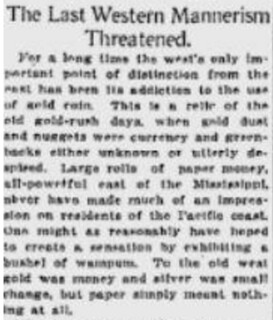 A Spokesman-Review editorial noted that one of the West’s last distinctive mannerisms — the preference for gold coins over paper money — was about to bite the dust.
A Spokesman-Review editorial noted that one of the West’s last distinctive mannerisms — the preference for gold coins over paper money — was about to bite the dust.
For a long time, the paper said, the West’s only important distinction over the “all-powerful East” had been its “addiction to the gold coin.”
“This is a relic of the gold rush days, when gold dust and nuggets were currency and greenbacks were either unknown or utterly despised.”
Consequently, Westerners were never much impressed with large rolls of paper money. While other Western mannerisms died out or were standardized, this one survived.
However, “the treasury department’s announced plan to take the gold piece out of circulation will finish the standardizing job, as far as the West is concerned.”
“East will no longer be East, and West will no longer be West,” said the paper, paraphrasing Kipling.
To read the complete article, see:
100 years ago today in Spokane: Gold coins, the currency of the West, losing to paper money juggernaut
(www.spokesman.com/stories/2017/feb/23/100-years-ago-today-in-spokane-gold-coins-the-curr/)

ARTIST LAURIE MCGAW'S CANADA 150 COIN DESIGN

A commemorative $3 coin produced to mark Canada's 150th anniversary features the artwork of Guelph artist Laurie McGaw.
The coin shows a "fun and inspiring collage of unmistakably Canadian symbols on a 99.99% pure silver coin," said the Royal Canadian Mint in a news release.
"Those [symbols] include our beloved Canadian flag, a birch-bark canoe, old fashioned lobster traps, an Inukshuk, wheat, the majestic Rockies, hockey sticks and many other icons that are Canadian to the core."

Oodles of doodles
"I thought it would be interesting to get as much as possible on a coin that you could still see and recognize... and simple enough that you can still see it down at the small size," McGaw told CBC News.
She said the first step in designing a commemorative coin like this is a simple doodle.
"I doodle and doodle and doodle, just out of my head. And then I spend hours and hours and hours doing research for images."
All art on Canadian Mint coins must be 100 per cent original, said McGaw. Even with portraits, the images "can't be just a reproduction of an existing photograph, it has to be an original interpretation of the pose or the images."
To read the complete article, see:
Ontario artist Laurie McGaw designed Canada 150 commemorative coin
(www.cbc.ca/news/canada/kitchener-waterloo/laurie-mcgaw-150-canada-coin-mint-1.3993183)
McGaw has designed several other coins for the Canadian Mint. In 2015 her artwork was featured on two coins released by the Royal Canadian Mint honouring the 100th anniversary of the creation of "In Flanders Fields."
"It's a coin, but it's still an illustration and it's problem-solving," she said of that design featuring Lt. Col. John McCrae. "Obviously, it's an honour. It's exciting and really quite neat to see them come out and be collected by people. It's a huge honour."
In 2011, she designed a coin commemorating the wedding of Prince William and Kate Middleton.
The new Canada 150 coin was launched on Feb. 16, Flag Day, as a way of honouring the Canadian flag, said a news release.
To read the complete article, see:
Guelph artist’s work appears on Canada 150 coin
(www.therecord.com/news-story/7156291-guelph-artist-s-work-appears-on-canada-150-coin/)
For more information, see Laurie McGaw's web site:
www.lauriemcgaw.com

ENGLISH BREAKFAST CONSIDERED FOR COIN DESIGN
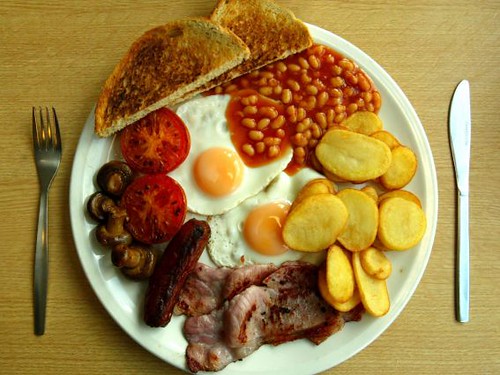
An engraving of a full English breakfast was considered to feature on the new £1 coin, the Royal Mint's chief engraver has said.
Gordon Summers said the fry-up was one of the most popular of more than 6,000 entries in a nationwide competition to find a design to appear on the tails side of the coin.
He told The Times: "You would be surprised at how many representations of the full English we had.
"We only really had 30 to 40 distinct ideas and great British breakfasts featured prominently.
"The breakfast designs were ruled out because the coin had to feature something that represented the four home nations and it had to be appropriate."
The competition was instead won by 15-year-old David Pearce, from Walsall, whose design featured a rose, leek, thistle and shamrock emerging from a Royal Coronet.
While the Royal Mint averted any questions about the breakfast appearing on the opposite side of the coin to the Queen, the Bank of England came under fire for using traces of animal fat to produce the new £5 note.
David adds:
Presumably French Euros would have a croissant?
To read the complete article, see:
Why Royal Mint took full English fry-up off pound coin menu
(www.newsandstar.co.uk/news/national/article/Why-Royal-Mint-took-full-English-fry-up-off-pound-coin-menu-0ac2e596-8d16-4b16-85da-97242f5c90c3-ds)
NUMISMATIC NUGGETS: FEBRUARY 26, 2017
Souvenir California Gold Tokens
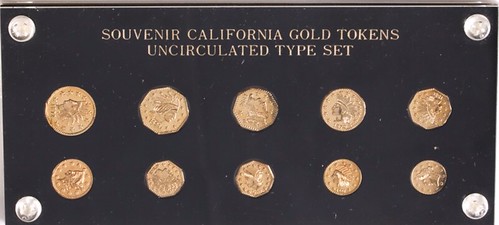

ITEM DETAILS
A group of replica souvenir California gold tokens. These are gold plated tin/copper tokens. They are grouped together in a nice display. The group includes ten different tokens that have a diameter between 13.5 mm and 10 mm.
DIMENSIONS
5.125" W x 2.375" H x 0.5" D
To read the complete lot description, see:
Group of Replica Souvenir California Gold Tokens
(www.ebth.com/items/5288381-group-of-replica-souvenir-california-gold-tokens)
Medals Commemorating Battles of the American Revolution

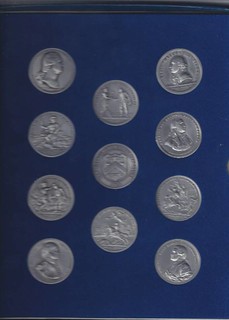
To read the complete lot description, see:
Americas First Medals United States Mint
(www.equip-bid.com/auction/2155/item/1344)
1963 Lincoln The Emancipator Medal
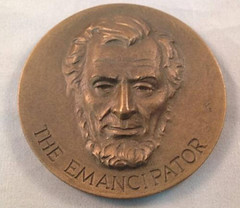
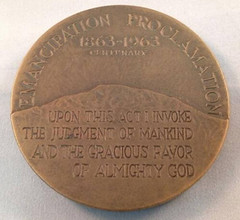
Lot 859: Lincoln Bronze Medal The Great Emancipator
Description: Bronze medal that measures approximately 2 1/2" and is embossed with the proclamation. Great piece of history...Good Luck!!
To read the complete lot description, see:
Lot 859: Lincoln Bronze Medal The Great Emancipator
(www.invaluable.com/auction-lot/-1-c-BE14434964)
1882 National Currency $5 Medicine Lodge, Kansas
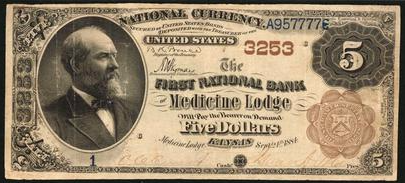
Medicine Lodge, Kansas. $5 1882 Brown Back. Fr. 467. The First NB. Charter #3253. PMG Very Fine 30. Serial Number 1. We have the privilege tonight of offering for the first time to the collecting community this incredible serial number 1 Five Dollar Brown Back from the First National Bank of Medicine Lodge, Kansas. This note represents a remarkable feat of survival as just $285 of the banks total issue of $40,060 in National Currency remained outstanding in 1910. This note is the only known surviving example of National Currency issued by the bank.
The town of Medicine Lodge is located in Barber County. Before the area was settled by whites it was occupied by the Kiowa people who believed the nearby Medicine Lodge River, or A-yadalda P'a as they called it, was sacred due to the high content of healing Epsom salts in the river. The Kiowa constructed a tabernacle a few miles south of the present day town for the celebration of their annual sun dance in 1866. The area was also the site of the Medicine Lodge Treaties signed between the United States and a number of different Plains Indians tribes including the Kiowa, Comanche, Apache, Arapaho and Cheyenne.
The bank issued only Five Dollar Brown Backs in sheets of four notes each. A total of 2003 sheets were issued by the bank before it was liquidated on March 1, 1894. The note offered here this evening is the Plate C note from the first sheet of notes ever issued by the bank. Medicine Lodge had one other note issuing national bank, the Citizens National Bank of Medicine Lodge, which operated from late 1886 until early 1891. That bank remains unreported with just $175 outstanding in 1910.
To read the complete lot description, see:
Unique for Town and Charter Medicine Lodge $5 Brown Back
(https://auctions.stacksbowers.com/lots/view/3-6THHB)
1914 German Empire Wilhelm II Silver Medal
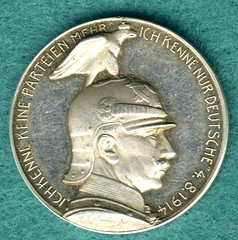
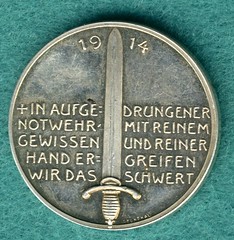
German Empire - silver medal 1914, Wilhelm II. Silver 990, 34.5 mm, 17.42 g.
To read the complete lot description, see:
73. German Empire - silver medal 1914, Wilhelm II.
(https://auction.catawiki.com/kavels/10358287-german-empire-silver-medal-1914-wilhelm-ii)
1914 German Empire East Prussia Silver Medal
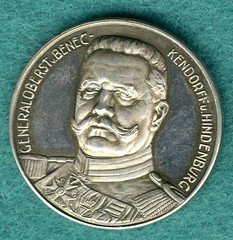
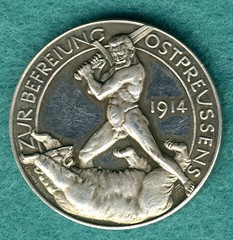
German Empire Silver medal 1914 to the freedom of East Prussia. 990 silver, 33.4 mm, 17.82g.
To read the complete lot description, see:
72. Empire - silver medal 1914 to the freedom of East Prussia
(https://auction.catawiki.com/kavels/10358143-empire-silver-medal-1914-to-the-freedom-of-east-prussia)
1900 Paris Summer Olympics Auto Racing Medal


Inspired by the games of the ancient Greeks, held in Olympia from the 8th century BC to the 4th century AD, 14 nations and 241 athletes came to Athens in 1896 to compete in 43 events in what is now known as the founding of the modern Olympic Games. At its conclusion, it was decided that in the spirit of world unity, a new Olympiad would be held every four years at a different host city around the world.
So in 1900, in conjunction with the International Exposition (later known as the World's Fair), the Games of the Second Olympiad were held in Paris, France. The games were expanded to 85 events with 997 members from 24 nations participating. Unlike the first Olympiad, women were permitted to compete (22 participated) and several "exhibition events" were added for the Paris Olympiad that never appeared again in subsequent contests.
One of those categories was auto racing, which was gaining world popularity with the advancement of the automobile. One winner of the 14 automobile events was French automobile pioneer Louis Renault, who founded what is now the 10th largest automobile maker in the world. Already a professional, Renault received prize money rather than a gold medal like the 22K solid gold piece offered here. If there was any doubt that auto racing was considered the up and coming event of the 20th Century, consider that the prize for track and field winners was a silver medal plated in gold while auto racing victors got the real thing, a designed plaque that was 50% larger in comparison and almost 92% pure gold.
The plaque measures 58 x 41 x 3 mm., weighs approximately 3.3 ounces and is stamped "OR" on the edge (French for "gold"). Designed by Frédéric Charles Victor de Vernon and produced by the Paris Mint, one side has an athlete standing at the podium above the words "CONCOURS D’AUTOMOBILES" (Automobile Contest) with Nike, the Greek goddess of victory on the other side, along with “REPUBLIQUE FRANCAISE – PARIS 1900 – EXPOSITION UNIVERSELLE." Designer "F. Vernon" is engraved in the lower right corner. Included is the original lined presentation box with a push clasp that opens it. This was the only Olympics that issued metal plaques to its victors, and of the few surviving specimens, none compare in quality to this NM to NM/MT specimen.
To read the complete lot description, see:
Extremely Scarce 1900 Paris Summer Olympic Games Gold Medal for Automobile Racing-Made of 22K Solid Gold
(www.milehighcardco.com/Extremely_Scarce_1900_Paris_Summer_Olympic_Games_G-LOT48689.aspx)
Katanga Cross
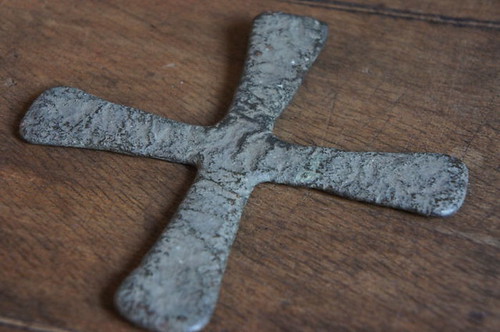
This small and exquisite cross, known as Katanga, was used as a form of currency (primarily) in the Congo and is considered to be a type of private money. The crosses were also placed in the graves of the dead in order that they would also have money / wealth in the realm of the dead.
These crosses were produced until about 1930, after this time, paper money was used.
This object is an authentic piece of tribal art!
Dates to: around 1900 or earlier
To read the complete lot description, see:
33. Katanga Cross - HANDA KATANGA - Belgian Congo
(https://auction.catawiki.com/kavels/10205065-katanga-cross-handa-katanga-belgian-congo)
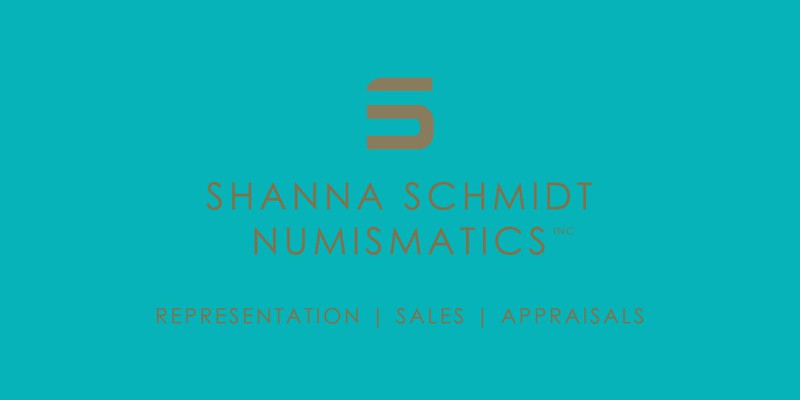
MORE ON NOODLE MONEY IN AMERICAN PRISONS
Speaking of primitive money, the March 2017 newsletter of the International Primitive Money Society (IPMS) notes that an IPMS meeting at the ANA National Money Show next month in Orlando, FL will feature President Charles Opitz, who will present a program on “Kesa, a form of traditional money from Choisoul Island in the Solomon Islands. The meeting will take place Friday March 10, 2017 at 1pm.
Also in the latest IPMS Newsletter is this article by Bob Leonard on noodle money in American prisons, a topic we covered on August 28, 2016 after the Washington Post article was originally published. With permission, here's Bob's article in its entirety. -Editor
NOODLE MONEY IN AMERICAN PRISONS
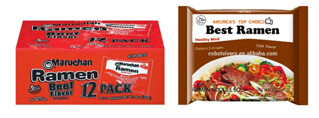 According to Amy B. Wang in The Washington
Post Wonkblog, August 23, 2016, instant ramen noodles
have “become the black-market currency in American
prisons.”
According to Amy B. Wang in The Washington
Post Wonkblog, August 23, 2016, instant ramen noodles
have “become the black-market currency in American
prisons.”
She reports that Michael Gibson-Light, a doctoral candidate in the University of Arizona School of Sociology, has completed a new study indicating that instant ramen noodles are overtaking tobacco as the preferred underground currency for prison inmates. Their main advantage? They are nonperishable, “ludicrously cheap,” easy to cook, and delicious.
Ah, but there may be political overtones here. Gibson-Light issued a press release on his study claiming that “Prisoners are so unhappy with the quality and quantity of prison food that they receive that they have begun relying on ramen noodles—a cheap, durable food product—as a form of money in the underground economy. Because it is cheap, tasty and rich in calories, ramen has become so valuable that it is used to exchange for other goods.”
Gibson-Light based his conclusion on interviews with 60 male inmates and staff members at a single state-run facility over a year’s time. Not surprisingly, he heard gripes about the cuisine at this institution. He then factored them in to a larger investigation into how prisoners were responding to “declining prison services,” claiming to have uncovered “punitive frugality,” that is, the cost of care shifting on to prisoners and their support networks because of shrinking corrections budgets. At this particular institution, about 15 years ago, hot lunches were replaced by a sandwich and a bag of chips, and portion sizes reduced, he was told.
Turning away from the advocacy aspect of this study, one inmate told Gibson-Light why ramen noodles were desired: “It’s ‘cause people are hungry. You can tell how good a man’s doing [financially] by how many soups he’s got in his locker. ‘Twenty soups? Oh, that guy’s doing good!’” Gibson-Light referred to this as a “prison ramen black market.”
Wang also quoted Gustavo “Goose” Alvarez, co-author of Prison Ramen: Recipes and Stories from Behind Bars, published November 2015. “Goose” spent time in prison twice, once in the mid ’90s and again from 2006 to 2013. “He quickly learned how critical ramen was to the inmate economy....‘It’s gold. It’s literally gold,’ Alvarez told The Washington Post. ‘People will actually—and I hate to say this but—they’ll kill for it, believe it or not.’”
“Alvarez said he never ate ramen before incarceration but quickly discovered that the cheap bricks were a no-brainer purchase at the prison commissary if he wanted to stretch his account. ‘It got to the point where some people would rather have a decent meal than a stogie, especially the way they’re feeding us in prison.’”
Like any currency, the value of a ramen pack fluctuated. “‘I remember in ’92, you could get them for 20 cents a ramen,’ Alvarez said. ‘In 2013, the last time I was in prison, they were equivalent to $1 a ramen, sometimes $2.’” Now living in Playas de Tijuana, Mexico, “Goose” does not associate ramen with prison; “His pantry is full of packs of Maruchan, still his go-to brand,” which he buys at Walmart.
Ramen was invented in 1958 by Taiwanese- Japanese entrepreneur Momofuku Ando and soon became popular worldwide. It is now a multibillion- dollar industry, according to Wang.
Your editor observes that ramen was already a popular prison currency a decade before hot lunches were eliminated at the state institution Gibson-Light visited. Also, smoking has been in decline in the United States for many years, clearly reducing the desirability of cigarettes as an alternative currency, even though it was permitted at the institution Gibson-Light saw.
Bob adds:
My account is skeptical in some respects, because the sociology student who did the study seemed to have an axe to grind.
To read the complete article, see:
RAMEN AS CURRENCY IN AMERICAN PRISONS
(www.coinbooks.org/esylum_v19n35a42.html)
NEW YORK TIMES REVIEWS IMAGES OF VALUE EXHIBIT
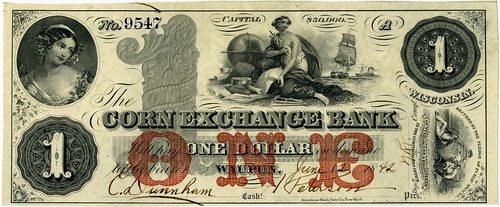
Money talks. And these days, it also walks.
American currency is set for its biggest image overhaul in decades as an old face is demoted — that means you, Andrew Jackson! — and some new ones, less uniformly white and male, arrive.
The images on legal tender are perhaps the most widely circulated art in the world, but where do they come from? That’s the question explored by “Images of Value,” an exhibition at the Grolier Club in Manhattan devoted to the underpondered truism that financial art, like the bills it is printed on, doesn’t grow on trees.
The more than 250 items on view come from the collection of Mark D. Tomasko, a retired lawyer who became fascinated by the beauty of financial art at age 10, when his grandmother gave him an obsolete stock certificate from the old Marmon Motor Car Company. Today he is the rare collector who focuses on tracking down the original artwork behind the engravings on bank notes, stock certificates and other financial documents.
“It’s a bit of an Easter egg hunt,” Mr. Tomasko said during a recent interview in the gallery, taking out his smartphone to show a visitor the hundreds of engraved “fancy heads,” or decorative female heads, he keeps on hand for reference. “I enjoy putting together the puzzle.”
The show, on view through April 29, presents a kind of shadow art history, driven not by bohemians in their studios or working en plein-air but by a rarefied if staid-looking crew of artists and engravers who suited up every day to work at outfits like the American Bank Note Company. The company was the king of an industry that — like the dollar itself — ruled the world well into the 20th century, when financial “dematerialization” and other forces took their toll.
Today, going cashless is easy, but when paper is required Mr. Tomasko likes his lucre very clean.
“I only use new money,” he said, pulling a hyper-crisp Benjamin out of his wallet to point out its high-tech anti-counterfeiting features.
And what happens when he gets change?
He paused, then said, deadpan: “I try not to get change.”
Here is a sampling of items Mr. Tomasko has retrieved from the vast, gorgeous and sometimes bewildering dustbin of American financial art history.
So Fancy
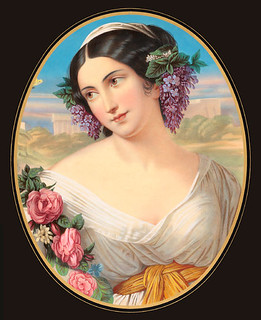 The “fancy heads” both prettied things up and made the documents harder to counterfeit. A $1 bill issued by the Corn Exchange Bank of Wisconsin in the 1850s or ’60s, shown at top, includes a head derived from a painting by the French artist Constant Joseph Brochart. Mr. Tomasko bought the lithograph shown above, which is based on Brochart, just because he liked it. Later he realized it had been engraved and used on a bank note. “It was entirely accidental,” he said.
The “fancy heads” both prettied things up and made the documents harder to counterfeit. A $1 bill issued by the Corn Exchange Bank of Wisconsin in the 1850s or ’60s, shown at top, includes a head derived from a painting by the French artist Constant Joseph Brochart. Mr. Tomasko bought the lithograph shown above, which is based on Brochart, just because he liked it. Later he realized it had been engraved and used on a bank note. “It was entirely accidental,” he said.
Founding Mother
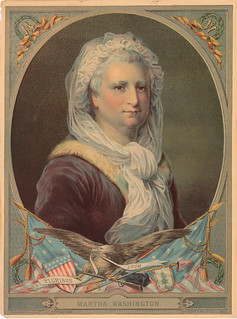 The first general-circulation United States currency appeared in 1861, when the government, to finance the Civil War, issued non-interest-bearing $10 demand notes, with Abraham Lincoln on the front. The United Stated Bureau of Engraving and Printing was created in 1874 and took over production of all American currency in 1877.
The first general-circulation United States currency appeared in 1861, when the government, to finance the Civil War, issued non-interest-bearing $10 demand notes, with Abraham Lincoln on the front. The United Stated Bureau of Engraving and Printing was created in 1874 and took over production of all American currency in 1877.
The faces on the front weren’t always the all-dude lineup we know today. Before there was Harriet Tubman (coming soon to the $20), there was Martha Washington, who appeared solo on the front of a $1 silver certificate in 1886 (shown above), and then alongside her husband on the back of another one issued in 1896. (Today, George has the $1 all to himself.)
The bureau has no record of the source image, but Mr. Tomasko said it was a portrait by Charles François Jalabert, which he also circulated via 19th-century cards, magazine illustrations and lithographs. Like all United States currency issued since 1861, these bills remain valid at their full face value, but if you want to buy an 1886 Martha, you’ll need to fork over as many as 1,500 Georges.
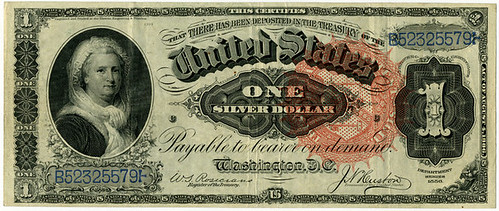
The Master
By the 20th century, American Bank Note and other companies commonly commissioned original art rather than taking images from the broader culture, partly because the salon art of the 19th century had given way to new movements whose images were “not suitable” for currency vignettes, as Mr. Tomasko’s catalog puts it.
If there’s a true maestro of this art in the show, it’s A. E. Foringer. Foringer, who trained with the muralist Edwin Blashfield, had his 15 minutes of fame with “The Greatest Mother in the World,” a Madonna-like Red Cross poster from 1918 — the only work mentioned in his 1948 obituary in The New York Times, Mr. Tomasko noted a bit forlornly.
But Foringer also had a long career as a vignette artist for American Bank Note, creating images that appeared on more than 50 international bills and many stock certificates, including a series for the Canadian Bank of Commerce in the 1910s and 1920s that Mr. Tomasko calls “the most beautiful bank notes of the 20th century.”
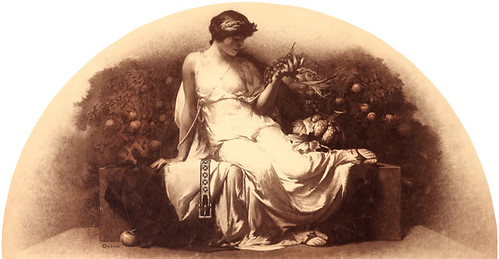
To read the complete article, see:
The Secret Art History on Your Money
(www.nytimes.com/2017/02/23/arts/design/the-secret-art-history-on-your-money.html?_r=1)
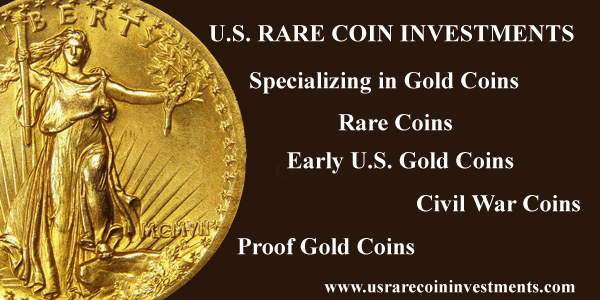
NORTHWEST TERRITORIAL MINT OWNER LOSES $38M VERDICT
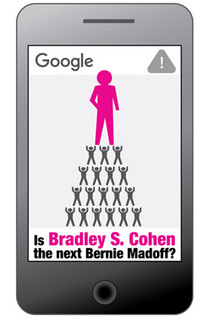 The internet is littered with demeaning, defamatory and just plain nasty statements. Tracking down an anonymous critic can be frustrating and expensive.
The internet is littered with demeaning, defamatory and just plain nasty statements. Tracking down an anonymous critic can be frustrating and expensive.
A relatively few hardy souls have felt aggrieved enough to file lawsuits; some have won judgments, a few in the multimillion-dollar category.
The Cohen case is the internet defamation battle on steroids, bringing together a wealthy victim willing to spend more than $3 million to identify and bring to court an attacker, who turned out to be well-heeled, sophisticated and persistent. That combination produced a cyberwar that climaxed last year with one of the largest internet defamation awards ever: a $38 million jury verdict for Mr. Cohen. The judgment is being appealed.
As he studied the website that ruined his Lake Como dinner, he saw hints of who might be behind it. It said a state-court suit by a Cohen-related investment entity involving a building it owned in the Seattle area, which was pending at the time, was an effort “to scam former tenants out of millions of dollars.”
The defendants in that suit were Ross B. Hansen and his company, Northwest Territorial Mint, which manufactured commemorative coins and medals and marketed precious metals.
The suit was prompted by Mr. Hansen’s refusal to clean up an environmental mess his company left behind when it vacated the building, said Mr. Cohen.
In court filings and depositions, Mr. Hansen, who declined to be interviewed for this article, vociferously denied the allegations. The judge in the case eventually found for Mr. Cohen’s side and, after an unsuccessful appeal, Mr. Hansen paid some $3 million.
A onetime Alaskan bush pilot, Mr. Hansen had founded and built Northwest Territorial Mint into a company with $200 million in annual sales and over 300 employees. His firm provided medals for the military and ornaments for the White House Christmas tree, and had a retail shop in the Pentagon.
Within a month, a cybercrime investigator new to the team, Michael Mitama, uncovered the real identity of the person who had used the Steven Finch pseudonym to set up the websites: It was Steven Firebaugh, an employee of Mr. Hansen’s firm.
With that information, Mr. Cohen added Mr. Firebaugh to the suit as a co-defendant.
Once identified, Mr. Hansen embraced his role as creator of the two websites. In a deposition, Mr. Hansen said he created them partly to show Mr. Cohen “for the liar, the thief, and the cheat that he is.” He said he came to that conclusion after being a tenant and defendant in the building litigation, which he felt Mr. Cohen improperly pursued.
After six days of testimony and arguments, when Mr. Cohen listened to the jury find in his favor on the defamation and invasion-of-privacy claims, four years of pent-up emotions finally burst forth. He broke down and cried.
Now, Mr. Cohen is searching for ways to recover at least some of the $38 million verdict. After the judgment, Mr. Hansen had his company file for bankruptcy protection.
Mr. Firebaugh, who was found liable for some of the monetary damages in the defamation case, joined the appeal. He subsequently filed for bankruptcy protection.
To read the complete article (subscription required), see:
One Man’s Bid to Clear His Name Online: 4 Years, $3 Million and Some Dead Turtles
(www.wsj.com/articles/3-million-dead-turtles-and-a-sex-website-inside-one-mans-bid-to-clear-his-name-on-the-internet-1487949319)
To read the complete article (subscription required), see:
West Coast Mint Files for Bankruptcy After Losing Defamation Suit
(www.wsj.com/articles/west-coast-mint-files-for-bankruptcy-after-losing-defamation-suit-1459553011)
To read the some earlier E-Sylum articles, see:
MEDALLIC ART COMPANY HAS A NEW OWNER
(www.coinbooks.org/esylum_v12n30a07.html)
NORTHWEST TERRITORIAL MINT ACQUIRES GRACO AWARDS
(www.coinbooks.org/esylum_v14n22a11.html)
ARTICLE PROFILES NORTHWEST TERRITORIAL MINT
(www.coinbooks.org/esylum_v16n36a22.html)
To visit the Northwest Territorial Mint web site, see: www.nwtmint.com

WAYNE'S NUMISMATIC DIARY: FEBRUARY 26, 2017
The regular night for my northern Virginia numismatic social group Nummis Nova turned out to be Valentine's Day this month, so to Ensure Domestic Tranquility we pushed our dinner back a week to Tuesday, February 21.
Steve Bishop was our host and he picked Coastal Flats in Fairfax Corner. They ended up seating us in a cluster of three separate booths, which we all thought inconvenient. But in the end I thought it was no worse than our usual arrangement of one long table where one can only converse with the few people in close proximity. A few of us booth-hopped as the night wore on. I thought the food was excellent, which was a plus.
I was the first to arrive but was soon joined in the lobby area by Howard Daniel and Joe Esposito. Others came soon after, including Wayne Herndon and his guest Rich Mahan. I ended up in a booth with Robert Hoppensteadt, Mike Packard and Joe Levine. We had great conversations on multiple numismatic topics. Other attendees included Julian Leidman, Tom Kays, Gene Brandenburg, Roger Burdette and Dave Schenkman.
President's Day Show-and-Tell
I didn't get to speak for long with Dave Schenkman, but as always he brought some great material to show. He writes:
Our theme, for President’s Day, was Lincoln and Washington. I brought one token representing each.
Only three embossed shell cards from Vermont are listed by Dave Bowers in his Guide to U.S. Shell Cards 1867-1880 (published by, and available from, the Token and Medal Society). One of them is extremely common; the other two are quite rare. This one is from the Bowers’ collection and he notes “2 or 3 known.”
The tokens of James E. Wolff, a Petersburg, Virginia dealer in hats and furs, are well known to collectors. Depicting a running wolf on one side and a tall hat on the other, it was struck in copper, brass, German silver , silver, and white metal (tin) during the 1850s. There are numerous varieties and with the exception of the silver striking, which is possibly unique, most are not rare. Following the Civil War, rare varieties were struck for collectors utilizing one of the Wolff dies in combination with Civil War dies. Those with a bust of Lincoln are excessively rare. This one, from the Ford collection, is in an NGC slab marked "ar" (silver). In fact, it is struck in German silver.
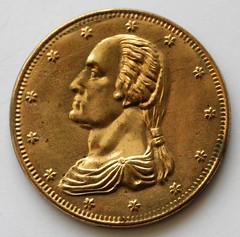
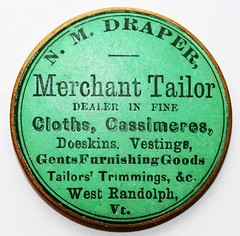
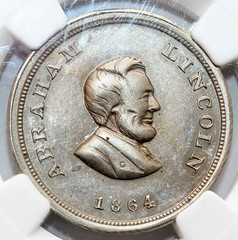
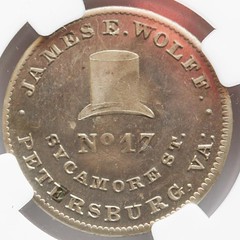
More Washington, Lincoln, and All the Presidents
Later in the evening I slid over to Steve Bishop's table. I'm still agog at the number of cards in his wallet.
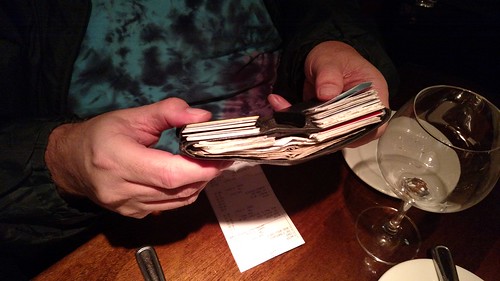
Joe Esposito was at that table as well. He'd brought a number of great items.


Sansom Medal

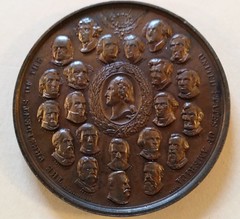
Lincoln Ferrotype; President's Medal
Joe writes:
Presidents Day represents a good opportunity to highlight numismatics, especially medals. There is, of course, an abundance of fascinating medals of George Washington, now impressively catalogued in Neil Musante’s recent two-volume work. Among the early pieces is the Sansom Medal, with dies by John Reich and issued by Joseph Sansom at the Philadelphia Mint in 1806. Its ornate reverse pays tribute to Washington’s great achievement of eschewing power: voluntarily giving up his military command and the presidency.
By Abraham Lincoln’s time, ferrotype campaign tokens had been introduced. In fact, there were many examples for all four candidates in the 1860 presidential contest. This 25-mm brass token represents a photograph of Lincoln taken at his famous Cooper Union speech by Mathew Brady. The reverse is a photograph of vice-presidential running mate Hannibal Hamlin.
Presidents as a group have been the source of many numismatic and quasi-numismatic items. Among the plethora of medals commemorating the Columbian Exposition in Chicago in 1893 was a 55-mm medal with a reverse of presidents up until that time, Washington in the center and ending with the incumbent, Grover Cleveland. The medal here is Eglit 35A.
As a boy I was enthralled by a game, “Meet the Presidents,” and I still have it. The game features an aluminum “coin” of each of the presidents through Harry Truman. The reverse has a brief biographical sketch. Answering questions from the wheel is the vehicle to success in this game, which provided me with hours of instruction in presidential history.


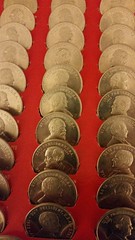
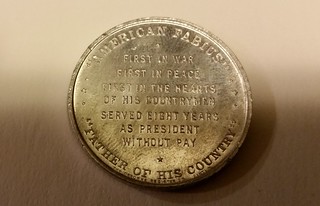
As always, it was a great night of numismatic fellowship, and we're already looking forward to March, when we'll have a bonus meeting at the Whitman Expo in Baltimore, where we can meet up with some of our out of town friends.
Breakfast with Jeff Garrett
American Numismatic Association President Jeff Garrett happened to be in town for meetings at the Smithsonian, and we arranged to meet for breakfast. His Uber dropped him off at my house and after taking him around for a neighborhood tour we slipped into the nearby IHOP and grabbed a table.
After a nice breakfast we stopped in the house to see my library, E-Sylum Central. Here are a couple snaps I took when I got up early to work a bit on this issue.
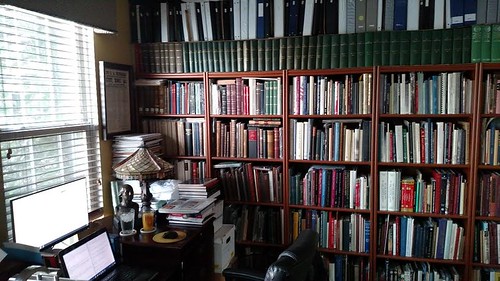

I like to stay hydrated. That's a half-finished E-Sylum on the top monitor. It was a short visit, as Jeff had to get back to his hotel and soon hopped into another Uber.
Off to St. Louis
Sunday morning February 26, 2017 I got up early, walked our dog and headed to Dulles airport, where I caught an 8:30 flight to St. Louis. My luggage held my clothes but mostly a large box of books and archival material being lent to the Newman Numismatic Portal for scanning. The NNP team was holding a planning meeting Monday at Olin Library at Washington University in St. Louis.
I had an early lunch at the St. Louis airport and took a cab to the Knight Center where a hotel room was waiting for me. I set up my laptop and worked on The E-Sylum most of the afternoon, using my phone to coordinate dinner with fellow NNP team members Len Augsburger and John Kraljevich.
At 6:45pm I met Len in the lobby to review the books I'd brought. We sorted through them and he took the box to his room. By around 7:15 JK joined us and Len drove to a great local diner. I had a basic burger, a side of jambalaya and a chocolate milkshake. Not low calorie by any stretch, but it sure was good. It had been years since I'd had a shake.
At dinner we tossed around a number of ideas for how the Newman Portal could help not just the numismatic community, but the larger community of academics and amateurs who aren't numismatists, yet could find much of value in the portal if only they could be made aware of its existence.
Back at the hotel around 9pm I got to work wrapping up this issue of The E-Sylum. As always, it was fun to put togehter - I hope you're enjoying it!
THE BOOK BAZARRE
MEDALS OF WILLIAM SHAKESPEARE
Dassier's Shakespeare Medal


DASSIER, Jean: England, ca.1733, Bronze, 43 mm Obv: Bust of Shakespeare (Facing) GUILIELMUS SHAKESPEARE. Rev: Mountainscape with meandering river WILD ABOVE RULE OR ART Exergue: NAT.1564. From Jean Dassier's Series, The British Worthies. Ref: Med. Ill. i, 208/42; Forrer I, p.516 (Illustrated); Eisler I, 283/1; Thompson 39/01; Weiss BW372
William Shakespeare (1564-1616) was the most celebrated poet and playwright of his time. His plays became known throughout the world and praised for their insight and use of the English language. Shakespeare was baptized at Stratford-upon-Avon, Warwickshire. His father, John Shakespeare, was a burgess of the borough, who in 1565 was chosen an alderman and in 1568 bailiff. William married Anne Hathaway of Stratford at the age of 18. It is not clear how his career in the theater began, but from about 1594 onward he was an important member of the Lord Chamberlain's company of players (called the King's Men after the accession of James I in 1603). They had the best actor, Richard Burbage; they had the best theater, the Globe; and they had the best dramatist, Shakespeare. He died in 1616 at Stratford-upon-Avon.
The portrait on Dassier's medal is taken from the Chandos picture, now in the National Gallery. The reverse is intended to characterize the genius and structure of the poet's works, coinciding with Johnson's opinion, 'The composition of Shakespeare is a forest in which oaks extend their branches, pines tower in the air, interspersed sometimes with weeds and brambles, and sometimes giving shelter to myrtles and roses, filling the eye with awful pomp and gratifying the mind with endless variety'. (from Thompson, p.39).
To read the complete article, see:
WILLIAM SHAKESPEARE
(www.historicalartmedals.com/MEDAL%20WEB%20ENTRIES/
JEAN%20DASSIER%27S%20SERIES%20OF%20BRITISH%20WORTHIES
/SHAKESPEARE-BW372%20HIGH.htm)
Boydell's Shakespeare Medal
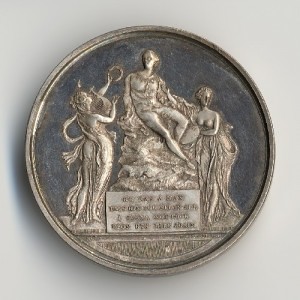
Thomas Banks' sculpture shown here on a medal. These medals were given to those who subscribed to an edition of Boydell's Shakespeare, 1803
To read the complete article, see:
William Shakespeare between Tragedy and Comedy
(http://findingshakespeare.co.uk/william-shakespeare-between-tragedy-and-comedy)
1816 Garrick Stratford Jubilee Medal
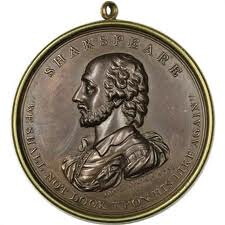
Back in 1769 a bronze medal had been struck by Westwood of Birmingham to celebrate the Garrick Jubilee in Stratford. In 1816 when the first celebration was held on Shakespeare’s birthday, a handsome bill proclaimed that “A beautiful medal… manufactured by Otley & Dowler of Birmingham, representing the Immortal Shakespeare was available in Stratford from Mr Ward. ”
Birmingham continued to supply medals to commemorate Shakespeare’s birthday celebrations, and several examples are shown on the Windows on Warwickshire website. Gentlemen from Birmingham were members of the Shakespearean Club, and took part in the annual celebrations held in Stratford.
To read the complete article, see:
Shakespeare connections: Stratford-upon-Avon and Birmingham
(http://theshakespeareblog.com/2014/01/shakespeare-connections-stratford-upon-avon-and-birmingham/)
1864 Shakespeare Tercentenary Medal
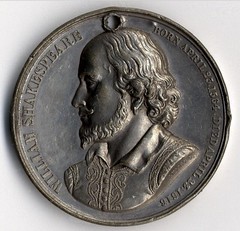
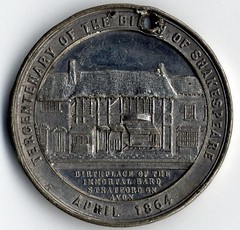
Medal struck to celebrate the tercentenary of the birth of Shakespeare. The obverse features the bust of Shakespeare facing left and the inscription 'WILLIAM SHAKESPEARE BORN APRIL 23.1564. DIED APRIL 23.1616'. The reverse features an image of Shakespeare's birthplace in Stratford-upon-Avon with the inscription 'BIRTHPLACE OF THE/ IMMORTAL BARD/ STRATFORD ON/ AVON'. The inscription around the outside reads 'TERCENTENARY OF THE BIRTH OF SHAKESPEARE/ APRIL 1864'.
To read the complete article, see:
Shakespeare Medal
(www.search.windowsonwarwickshire.org.uk/Details.aspx?&ResourceID=16941)
1964 Shakespeare 400th Anniversary Medal
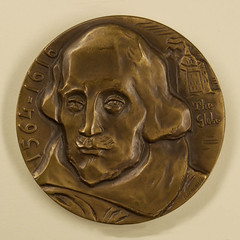
A bronze medal commemorating the 400th anniversary of Shakespeare's birth, 1964. Made in the Soviet Union, designed by I. Daragan.
Marks & inscriptions
inscription : : obverse : head of Shakespeare to left, Globe Theatre in background right : 1564-1964 THE GLOBE, inscription : : reverse : lines from sonnet 54 as translated into Russian by Samuil Marshak (1887-1964) : Prekrasnoe prekrasnej vo sto krat, uvenchannoe pravdoj dragotsennoj (The beautiful is a hundred times as beautiful crowned by the precious truth), inscription : : reverse : Quotation from Sonnet 54 : O HOW MUCH MORE DOTH BEAUTY BEAUTEOUS SEEM/BY THAT SWEET ORNAMENT WHICH TRUTH DOTH GIVE, inscription : : reverse : William Shakespeare transliterated into Russian :,
To read the complete article, see:
Commemorative Shakespeare medal
(http://collections.shakespeare.org.uk/search/museum/strst-sbt-1969-2-commemorative-shakespeare-medal/search/material:metal/view_as/grid/page/5)
To read the earlier E-Sylum article, see:
ROCKEFELLER'S SHINY DIMES
(www.coinbooks.org/v20/esylum_v20n08a17.html)
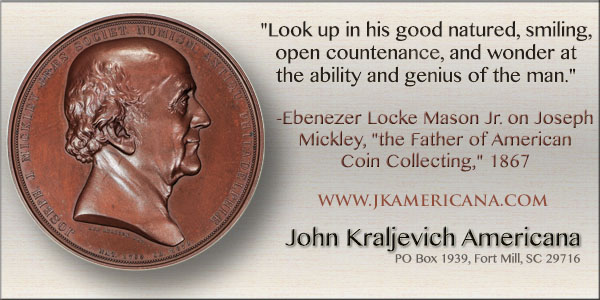
MEDALS OF BONNIE PRINCE CHARLES
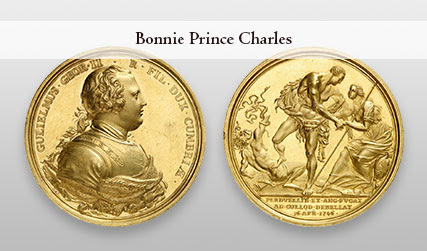
From Künker sale 292 (16 March 2017), No 5696. Medal 1685 on the execution of James Scott and Archibald Campbell after the suppression of the Monmouth Rebellion, which tried to prevent the Catholic James from ascending to the throne.
In 1814, Sir Walter Scott published his first historical novel entitled Waverly. He had chosen a topic, which should still make bestseller-authors rejoice, even to this day: A young prince who tries to recapture his father's kingdom against all reason. He is of course not supported by those in power, but rather by those who live on the edge of society, who are behind in technology but morally superior – the clans. They are defeated by the modern technology of the rulers, but the young prince manages to escape at the last second.
As it turns out, all of these clichés are true. The handsome Prince Charles, Bonnie Prince Charles, as the Brits still call him today, was the last Stuart, who sincerely tried to undo the Glorious Revolution, with the help of the Clans of the Scottish Highlands.
His grandfather, James II reigned from 1685 until 1689. He was Catholic and had tried to wrest more tolerance towards the Catholics and Quakers from the Protestant establishment. However, this would have meant that traditional higher classes would have had to cede some of their power. Of course they were not willing to do so. Thus they invited the son-in-law of James II, the Calvinist William of Orange, to take leadership. James had to flee.
See the web site article for several medals releated to the topic. However, when I last checked I had trouble displaying the images.
Interesting side note: Lot 5076 is a 1746 Gold medal "by R. Yeo". American numismatists see "R. Yeo" and think of Richard Yeo, the founding editor of the classic A Guide Book of United States Coins, published under his pen name Richard Yeoman. Can anyone tell us more about the engraver R. Yeo? Could they be related somehow? -Editor
To read the complete article, see:
Bonnie Prince Charles
(www.kuenker.de/de/information/presseinformationen/aktuelle-mitteilungen/124)
MEDAL MARKS 450 YEARS OF NETHERLANDS MINT HISTORY
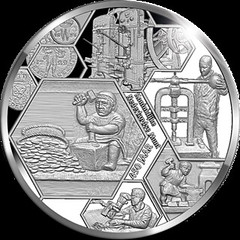

The Royal Dutch Mint have issued a new medal in celebration of Dutch numismatic history, which began in 1567 in the city of Utrecht, home of the Royal Dutch Mint. For centuries, gold and silver coins minted under the authorities of the Dutch provinces earned the highest respect for both their quality of production and their strict adherence to weight and purity standards. The rijksdaalders, guilders, stuivers, and ducats that financed Dutch exploration and trade all over the world also became, in many parts of the world, the very standard for local coinage and currency. The easily recognised and familiar coins carried the crests of the varied states and even cities within the Dutch states. Today, the coins of the modern Kingdom of the Netherlands are some of the most widely collected internationally, for the same reasons the coins were admired long ago: their beauty, their quality, and their accuracy in terms of metal and weight. With the accession of Queen Beatrix in April 1980, the Netherlands Mint undertook to produce some of the most modern and technically advanced coins the world had ever seen, and the mint gained further respect and admiration for their ground-breaking designs.
The Netherlands Mint was, for a very long time, one of the country’s oldest existing businesses, and it became especially important after the 1581 unification of all the Dutch provinces into the Dutch Republic. The initial mint was inaugurated by Spain’s King Philip II (who was at the time king of the Spanish Netherlands), and it this entity that lasted until 1795. With the turmoil in France, the emergence of the Batavian Republic—which was allied with Emperor Napoleon and his empire—resulted in the formation of the Kingdom of Holland, with Napoleon’s younger brother Louis being declared king. The Dutch mint produced the coins of Louis Napoleon and from September 1806 he appointed them the sole entity for the minting of coins for the Netherlands.
This arrangement lasted until 1811, when it the Dutch Republic became a province of France; it remained so until the capitulation of Napoleon and the end of the French Empire in 1813. In place of Louis Napoleon, the Dutch provinces united behind Prince William of Orange, who became king of the newly created United Kingdom of the Netherlands (which included the present-day country of Belgium). The mint was renamed ’s Rijks Munt (the Rijk’s Mint), and an additional minting facility was established in Brussels. When independence was granted to the Belgians under the leadership of Prince—now King—Leopold of Saxe Coburg Gotha, the mint in Utrecht was once again the only coin-producing facility in the Netherlands.
The Rijk’s Mint underwent substantial change in 1910, when a new building was completed on the grounds of the City of Utrecht’s post office. The distinctive building, which is a listed landmark, is today of one of the region’s main tourist attractions. The location was strategically chosen, as the building is bordered by a canal that enables the coins to be transported by riverboats to the National Bank in Amsterdam.
The Rijk’s Mint officially became a state institution in 1912 under the auspices of the Royal Treasury. In 1994, with a reformation of the structure of the treasury by the Dutch government, the Rijk’s Mint transitioned into the new Netherlands Mint, an entity operated as a private firm with 100% of its shares vested in the treasury (which is under the authority of the Ministry of Finance). The Netherlands Mint was further enhanced in 1999 when Queen Beatrix awarded the Mint the prefix of “Royal,” thus enabling it to refer to itself as the current Royal Dutch Mint. In November 2016, the Royal Dutch Mint was sold to a private firm in Belgium, who have taken up the task of restructuring the debts and expenditures due to failed contracts for the production of coins abroad that resulted in penalties and fines.
The crown-sized medal’s design includes various scenes of coin production from the earliest times to the latest technology currently use in coin production. The commemorative inscription on the primary side includes Koninklijke / Nederlandse Munt / 450 JAAR, with the anniversary years 1567–2017 shown on the opposite side.
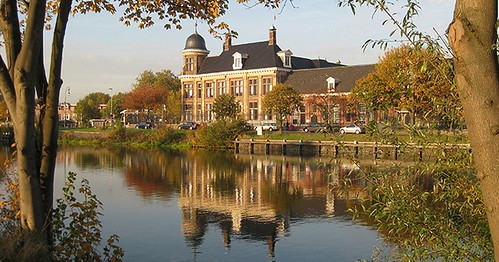
The Royal Dutch Mint, located on the Merwede Canal, Utrecht, the Netherlands
To read the complete article, see:
The Netherlands: Celebration medal marks 450 years of mint history
(http://news.coinupdate.com/the-netherlands-celebration-medal-marks-450-years-of-mint-history/)

CANADA'S NEW ENDANGERED ANIMAL CUTOUT COINS
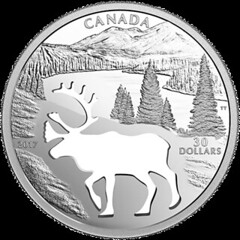
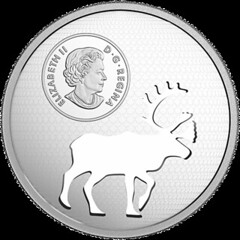
The Royal Canadian Mint have launched the first coin in a series that will highlight endangered species indigenous to Canada and North America. To symbolise these species’ being cut out of existence, each coin will feature a cutout of the silhouette of the subject animal within in its natural habitat.
State-of-the-art technology and internationally renowned craftsmanship have come together to produce the first coin, which depicts the woodland caribou (Rangifer tarandus caribou). Sadly, this majestic mammal joins other Canadian creatures that are classified as at risk, threatened, or even endangered—particularly the Southern Mountain population of caribou, which is listed as threatened on Canada’s Species at Risk Act (SARA). The coin represents an artistic tribute to a beloved species, and the overall design offers a haunting re-imagining of the Canadian wilderness without this national icon.
Designed by Canadian artist Trevor Tennant, the coin transports the onlooker to the mountainous landscape of western Canada, where detailed engraving and multiple finishes recreate a timeless snapshot of the wild. The distant peaks provide a breath-taking backdrop to the grassy foothills, which slope down to the tree-lined river below; and while the beauty of the engraved scene is unmistakable, it is the uniquely shaped cut-out that easily draws the viewer’s eye. Innovative technology has skillfully carved out the outline of a woodland caribou, smoothly recreating its distinctive profile and towering rack of antlers. With its uniquely shaped cut-out, this pure silver coin shines the spotlight on the plight of the caribou, a national symbol whose numbers are in decline in Canada’s wilderness.
This is taking low relief to the ultimate level - no relief, no nothin'. It's also the ultimate use of negative space in medal (excuse me, "coin") design. While those design elements usually leave me... well, flat... I think the cutout works quite well here and is a genius move, perfectly matching the theme of the series, showing what a nature scene would look like without the animal in question.
I'm less thrilled with the other side of the piece, where the Queen seems an out-of-place add-on, probably there only because the law says she must appear on Canadian coins. -Editor
To read the complete article, see:
Canada: New Endangered Animal Cutout series features woodland caribou
(http://news.coinupdate.com/canada-new-endangered-animal-cutout-series-features-woodland-caribou/)
PETITION SEEKS TRUMP U.S. GOLD COIN
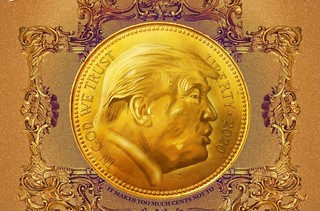 Regardless of your political affiliation, it’s safe to say this is a very different Presidency than what the country has become used to. Love him or hate him, very few people have a neutral opinion about Donald Trump. Now there’s a petition on Change.org to make an exception to federal law to allow for the creation of a gold coin bearing Trump’s likeness. Presenting the Trump Gold Coin?
Regardless of your political affiliation, it’s safe to say this is a very different Presidency than what the country has become used to. Love him or hate him, very few people have a neutral opinion about Donald Trump. Now there’s a petition on Change.org to make an exception to federal law to allow for the creation of a gold coin bearing Trump’s likeness. Presenting the Trump Gold Coin?
The petition starts out: “Every great ruler throughout history has had his face on a gold coin. Unfortunately a “federal law” prohibits living persons from being on U.S. coinage. Here’s why that needs to change.” The Founding Fathers passed a law early on in the United States preventing living persons from having their likeness on currency, presumably to differentiate the U.S. and its elected leadership from other countries which were ruled by a hereditary monarchy.
However, instead of aligning Trump with a monarchy, the petition goes on to align him with the common person: “Additionally, Donald J. Trump is the first successful reality television icon to ever become President. Ronald Reagan was a movie star, aligning him with the Hollywood elite. Reality television is the people’s television.” What could possibly go wrong?
There’s even a corresponding infographic that lays out the argument for putting Donald Trump on a gold coin, and the points of argument include:
- His Manhattan apartment is decorated with 24 karat gold
- He isn’t susceptible to bribes because he has more money than he will ever need
- He is the only person who can make America great again, according to himself
To read the complete articles, see:
President Trump on a Gold Coin?
(www.valuewalk.com/2017/02/trump-gold-coin/)
President Trump on a Gold Coin
(https://invest.usgoldbureau.com/president-trump-gold-coin)
To read or sign the petition, see:
Put Trump On A Gold Coin
(www.change.org/p/steven-terner-mnuchin-secretary-of-the-treasury-put-trump-on-a-gold-coin)
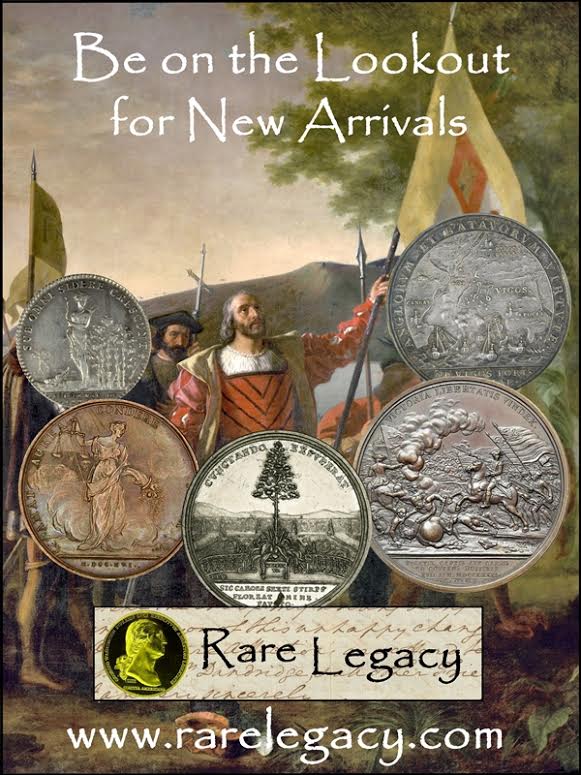
COUNTERFEITING CURRENCY FOR THE VIETNAM WAR
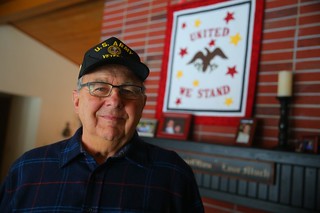 Charles J. Zoerb never set foot in Vietnam, but from his printing presses on Okinawa he helped create weapons to expose North Vietnamese infiltrators and help demoralize the enemy.
Charles J. Zoerb never set foot in Vietnam, but from his printing presses on Okinawa he helped create weapons to expose North Vietnamese infiltrators and help demoralize the enemy.
So, in his case, you could say the pen was mightier than the sword.
And Zoerb was well prepared for his role in the Army’s 15th Psychological Operations printing branch. Before he was drafted, he had worked as a printer at Arcata Graphics in Cheektowaga.
Twenty-two years old at the time, Zoerb had never imagined he would be able to utilize his civilian trade. He was certain that when he was drafted he was destined to serve in the Army infantry in Vietnam.
With a top secret security clearance, he arrived on the Pacific island of Okinawa on Feb. 18, 1966, assigned to a fully furnished print shop that operated nonstop.
Under the guidance of U.S. military brass and South Vietnamese officials, Zoerb and 29 other printers produced counterfeit money and propaganda leaflets.
The fake currency, he said, was the more devious of what rolled off the presses.
“It was scattered from airplanes flying above North Vietnam. When infiltrators headed to South Vietnam with that money, they could be identified because the cash had special markings and serial numbers,” Zoerb explained.
Those caught carrying the fake bills would be arrested and interrogated, he said.
“We printed tens of millions of these bills to also flood and destroy the economy in the north,” he added.
The South Vietnamese officials, Zoerb said, paid the printers a rich compliment when they expressed amazement over the quality of the counterfeit cash.
The counterfeit operation occurred on the midnight shift for security purposes. During the day and evening shifts, printers churned out the propaganda pamphlets.
To read the complete article, see:
Vietnam-era veteran counterfeited, legally, to make life hard for enemy
(https://buffalonews.com/2017/02/19/vietnam-era-veteran-counterfeited-legally-make-life-hard-enemy/)
BILL ENGRAVED WITH MICRO-PORTRAIT FOUND

An Irish woman who found a rare five-pound note engraved with a portrait of Jane Austen has donated it to charity.
The note, worth an estimated £50,000, was found in Northern Ireland by a woman known only as "J".
She sent the fiver back to the Scottish gallery it came from, and asked for it to be used to benefit a charitable cause.
"£5 note enclosed, I don't need it at my time of life. Please use it to help young people," she wrote.
The anonymous benefactor is known to be from County Donegal in the Republic of Ireland.
The gallery created the notes in conjunction with Birmingham micro-artist Graham Short.
Just four notes were specially engraved and spent in each of the home countries.
The first was found in a café in south Wales in December, with the second discovery coming in Scotland inside a Christmas card the same month.
The artist, Graham Short, had previously told the BBC that he spent it "in a small bar called Charlie's Bar".
When the gallery asked the woman to prove her find, she sent them a picture of the note, verifiable through its serial number, along with a dated copy of her local newspaper, the Donegal Democrat.
To read the complete article, see:
Mystery Irish woman gives £50k fiver to charity
(www.bbc.com/news/uk-northern-ireland-39042329)
Birmingham micro-artist Graham Short engraved minuscule 5mm portraits of Jane Austen onto the fivers.
Three of the four have already been discovered, the latest being found in a Northern Irish Bar.
Quotes from Austen's classic works have been carved onto the notes, and although they can be seen with the naked eye, a microscope is required to see the detail properly.
Now is the time to start searching down the back of the sofa, or in the pockets of your jeans for the elusive note.
The quotes inscribed on the banknotes are:
• AM32 885552: "To be fond of dancing was a certain step towards falling in love," from Pride and Prejudice
• AM32 885554: "I hope I never ridicule what is wise or good," from Pride and Prejudice
• AM32 885553: "A large income is the best recipe for happiness I ever heard of," from Mansfield Park
• AM32 885551: "If I loved you less, I might be able to talk about it more," from Emma
To read the complete article, see:
One of four rare Jane Austen five pound notes worth £50,000 remains undiscovered
(www.essexlive.news/one-of-four-rare-jane-austen-five-pound-notes-worth-50-000-remains-undiscovered/story-30162929-detail/story.html)
To read the earlier E-Sylum article, see:
ARTIST SPENDS BILL ENGRAVED WITH MICRO-PORTRAIT
(www.coinbooks.org/esylum_v19n51a30.html)
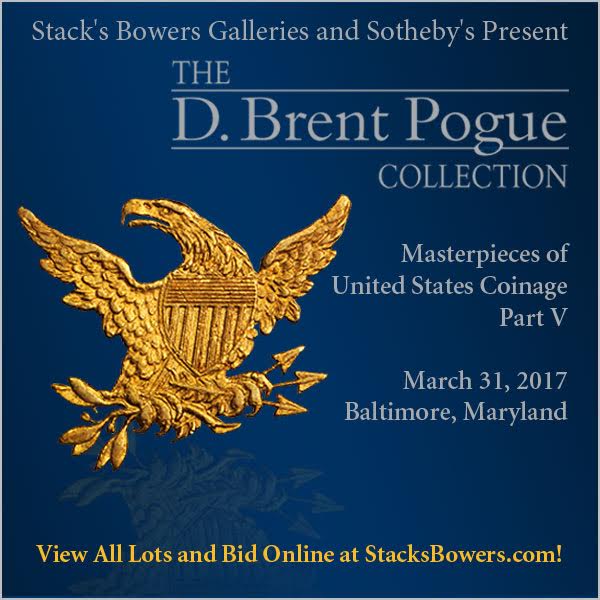
INDIA ATM DISPENSES PLAY MONEY
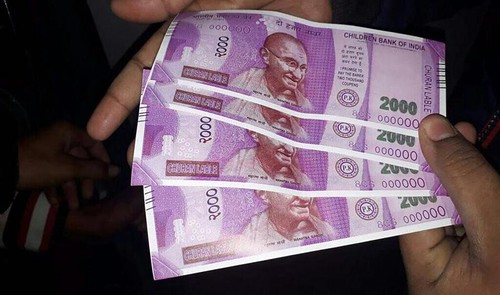
India’s banknote crisis has plumbed new depths of farce after a cash machine in Delhi began issuing fake money, apparently from a toy shop.
The owner of a cash delivery company has been arrested after the machine in southern Delhi dispensed 2,000-rupee (£24) notes stamped by the “Children Bank of India”.
When customers complained, police initially believed that they had uncovered a counterfeiting scam. Further inspection revealed that the fakes could be purchased in most toy shops. The notes all bore the serial number 000000.
The incident has again fuelled criticism of the decision by Narendra Modi, the prime minister, to scrap the 1,000-rupee and 500-rupee notes overnight in November in an attempt to prevent tax evasion.
The country was thrown into chaos as panicked Indians lined up outside banks to exchange now-worthless cash savings, and much of the economy ground to a standstill. For several days India’s most valuable note was the 100 rupee, worth £1.20.
Accusing him of exchanging five original Rs 2,000 currency notes with the ‘Children’s Bank of India’ notes, Delhi Police has arrested a 27-year-old man who worked at an ATM cash loading company in connection with the fake notes that were dispensed by an SBI cash machine earlier this month.
The 27-year-old accused, Mohd Isha, had been employed with a logistics and cash management firm for over a year. He was the custodian of the cash deposited in the SBI ATM in Sangam Vihar on the day the bogus notes were dispensed.
Romil Baaniya, DCP (South-East), alleged that their investigation pointed towards Isha’s role in replacing the notes. “No one else had access to the notes that day. He removed five genuine notes and replaced them with the bogus notes which are easily available in the market and are used by children for playing purposes,” Baaniya said.
To read the complete article, see:
Children Bank of India: Cash loader held for fake Rs 2,000 notes in Delhi ATM
(www.hindustantimes.com/delhi/children-bank-of-india-atm-cash-loader-arrested-for-replacing-rs-2000-notes-in-south-delhi/story-h0Vrc4YpD1Pv1Xrw8PjgyO.html)
To read the complete article, see:
ATM issues toy money as cash crisis deepens
(www.thetimes.co.uk/article/atm-issues-toy-money-as-cash-crisis-deepens-hwt7lpl6f)

CHINESE BANKNOTE BOUQUET

Sometimes finding a present for a loved one can be hard.
However this man in Changchun, China proved that he can be inventive when thinking of a gift for his girlfriend, giving her a bouquet that is more than meets the eye.
The flowers were made from notes totaling 10,000 yuan (£1,168) and handed to the man's girlfriend in order to start the year of the rooster 'right'.
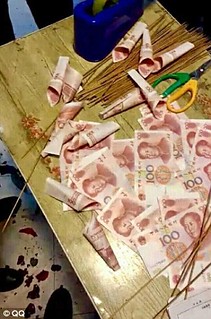 According to QQ.com, the man went into a flower shop in Changchun, Jilin province with a bag of 10,000 yuan (£1,168) on 13 February.
According to QQ.com, the man went into a flower shop in Changchun, Jilin province with a bag of 10,000 yuan (£1,168) on 13 February.
He asked the owner of the shop to make him a bouquet of roses using the notes.
The man told the owner of the shop that he wanted to give his girlfriend the 'right start' to the year of the rooster.
To read the complete article, see:
Who needs roses? Man declares his love to his girlfriend with a £1,100 bouquet made of banknotes
(www.dailymail.co.uk/news/article-4248794/Man-declares-love-1-100-bouquet-banknotes.html)
FEATURED WEB SITE: THE GREAT SEAL
This week's Featured Web Site is the Great Seal.
Designed by some of America's most visionary Founders during the revolutionary birth of our nation, the Great Seal is the carefully crafted message they created to convey their vision to the world, and to the future.
As our nation's vision statement, its two sides embody the essential guiding principles these farsighted patriots knew the United States must always follow.
So important was the Great Seal that on Day One – July 4, 1776 – Congress appointed Benjamin Franklin, John Adams, and Thomas Jefferson to begin the design process that would later involve two other committees.
Considerable attention went into creating the Great Seal. Unfortunately, most historians and educators have overlooked this extraordinary symbol. Consequently, myth and misinformation are commonplace, and the eloquent symbolism of the Great Seal is not fully appreciated.
It is time to rediscover our nation's forgotten treasure, the Great Seal of the United States, by telling Americans the fascinating story of this emblem that represents them.
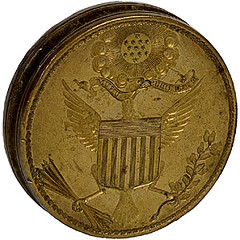
http://greatseal.com/

